

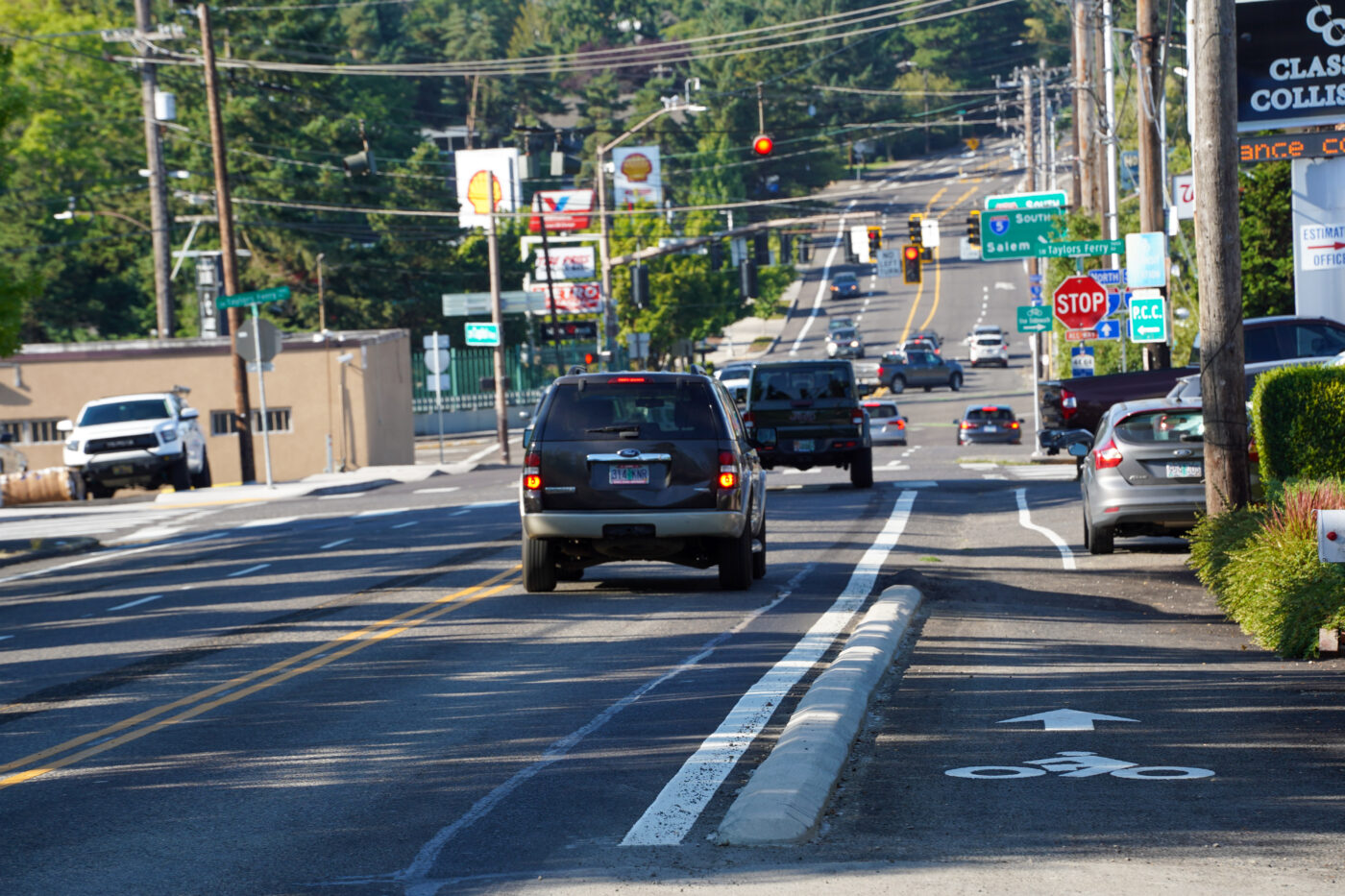
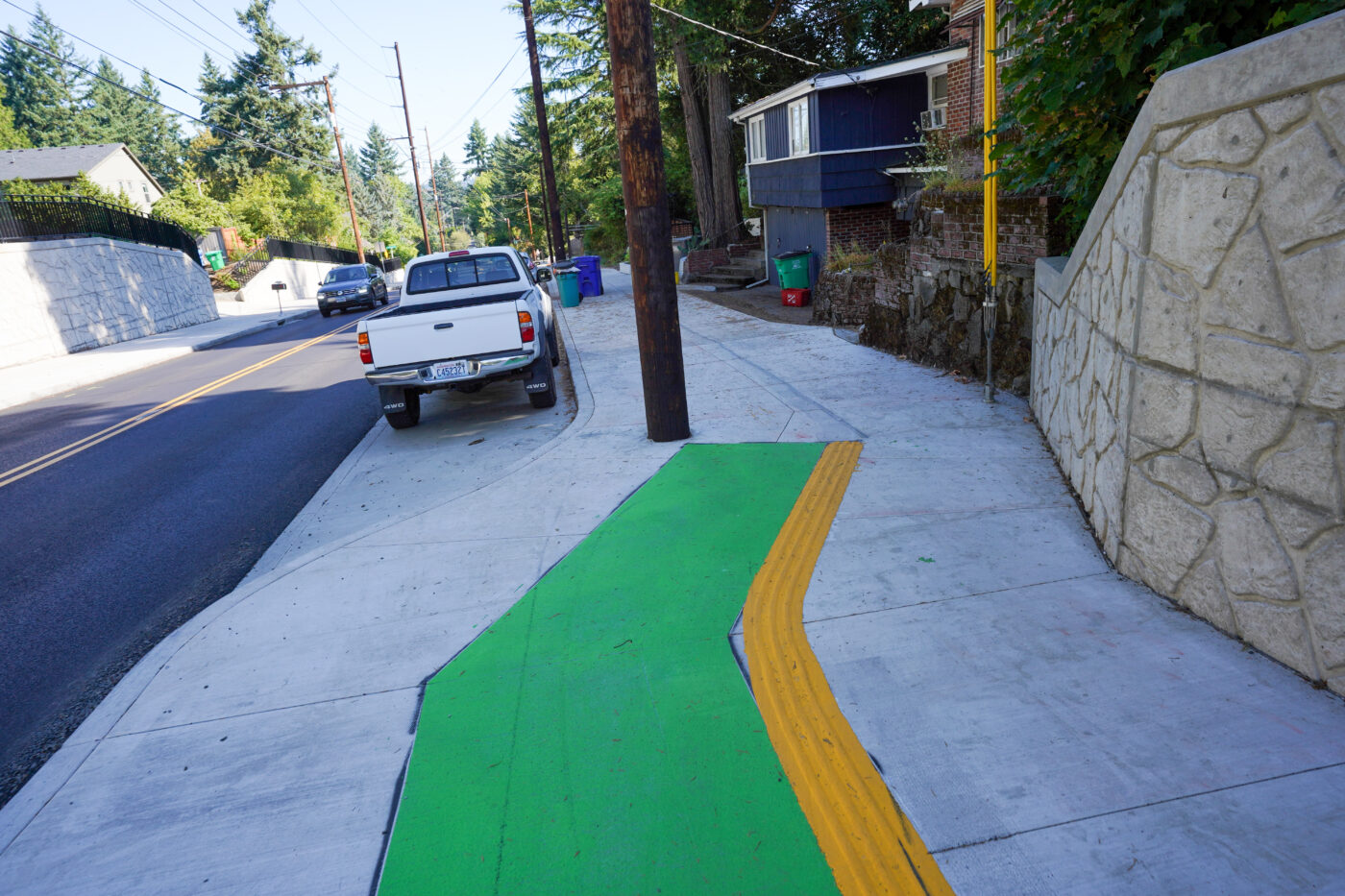
Back in July, the City of Portland finally cut the ribbon on their $30 million makeover of Southwest Capitol Highway. This morning I finally got out there to take a closer look.
The project stretches about one mile from SW Garden Home Road (near Multnomah Village) to SW Taylors Ferry Rd (near I-5). And if you’re wondering why we spent $30 million on one mile of road, keep in mind that this was much more than just a transportation project. In addition to new sidewalks, bikeways, curbs, and pavement, the City also laid down 7,000 linear feet of stormwater pipe, 3,000 linear feet of water main, built three large stormwater treatment gardens and built 13 retaining walls.
Combine all that with the fact that folks have been asking for this for over 30 years, and the City had to cut into the yards of about 100 homes to gain the width for the sidewalk and bikeway — and you understand why it was such a big deal to finally get it done. And in a part of town like southwest, where it’s almost impossible to ride a bike in most areas, having a mile of protected bikeways on a major street is nothing to shake a frame pump at.
This morning I rode it a few times. Scroll down for a full photo gallery and video ride-through.


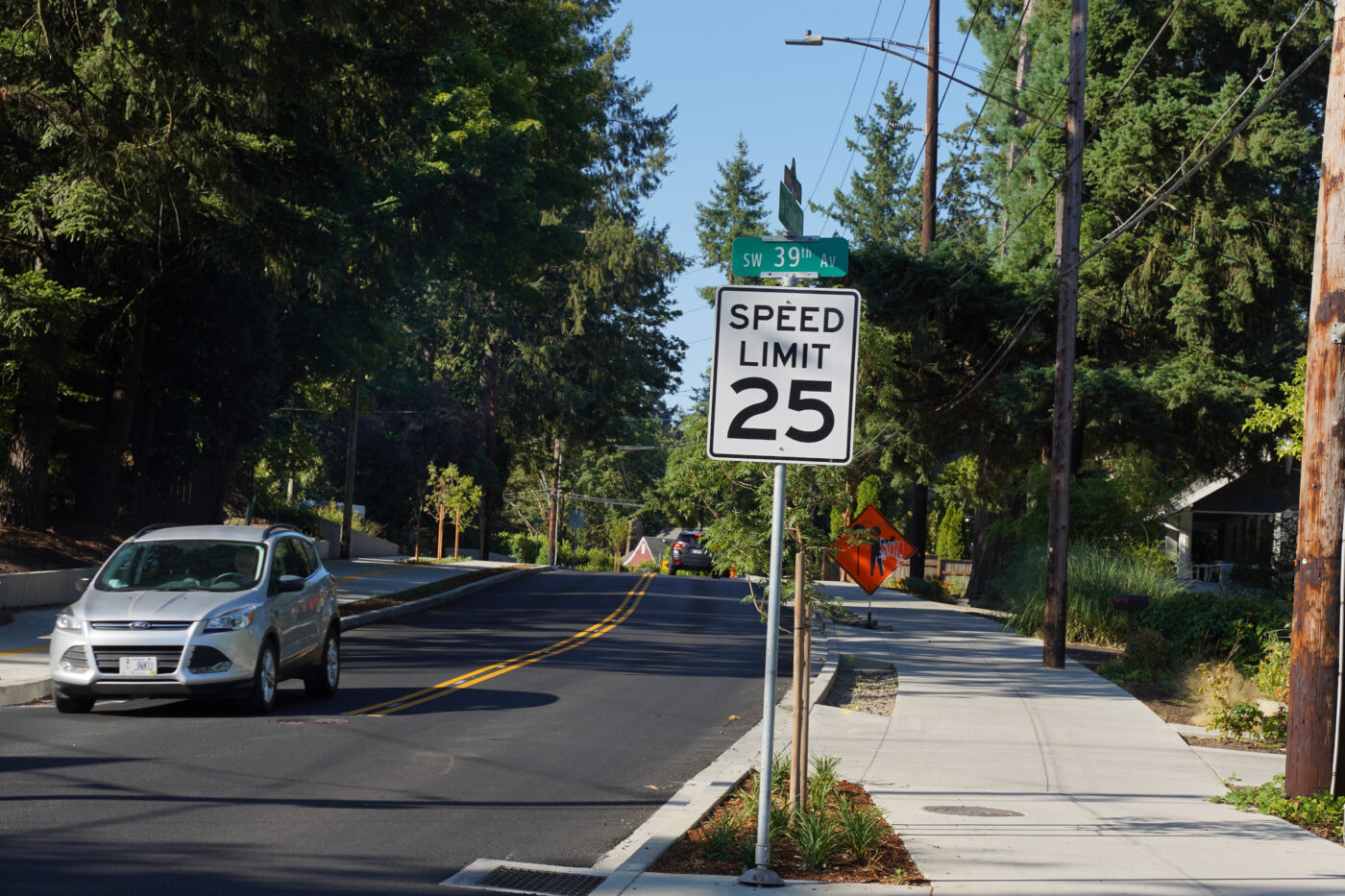


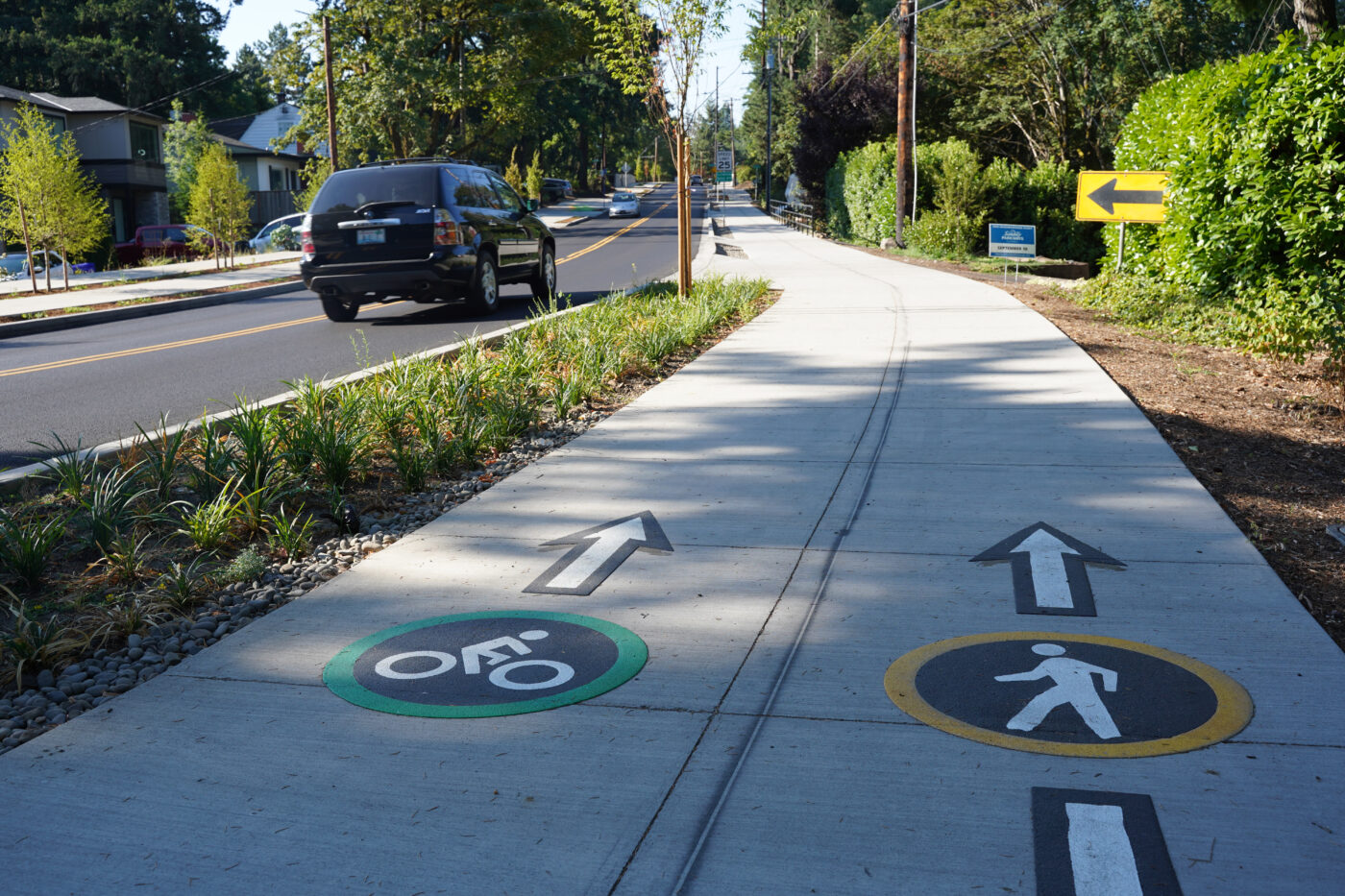


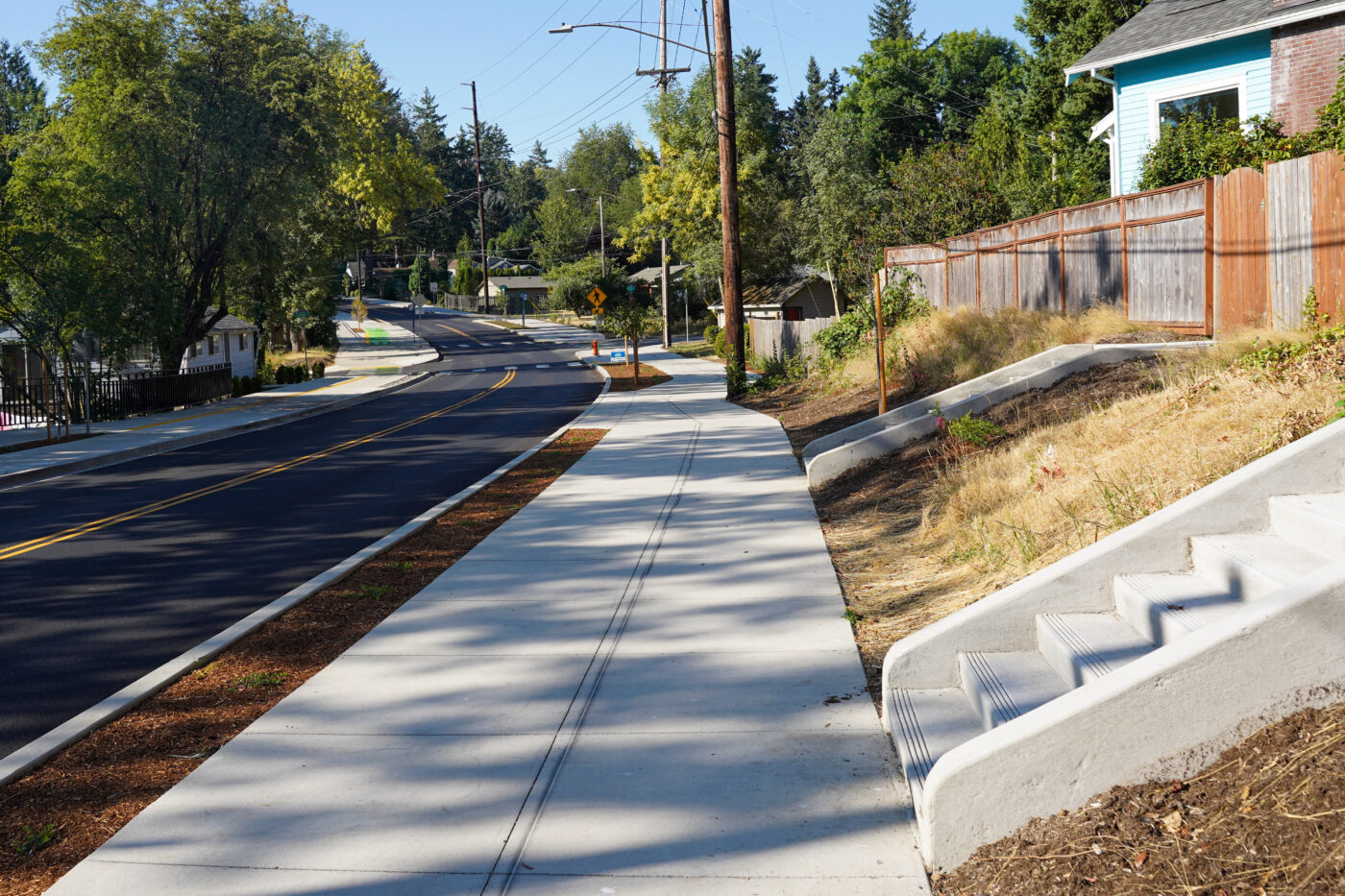

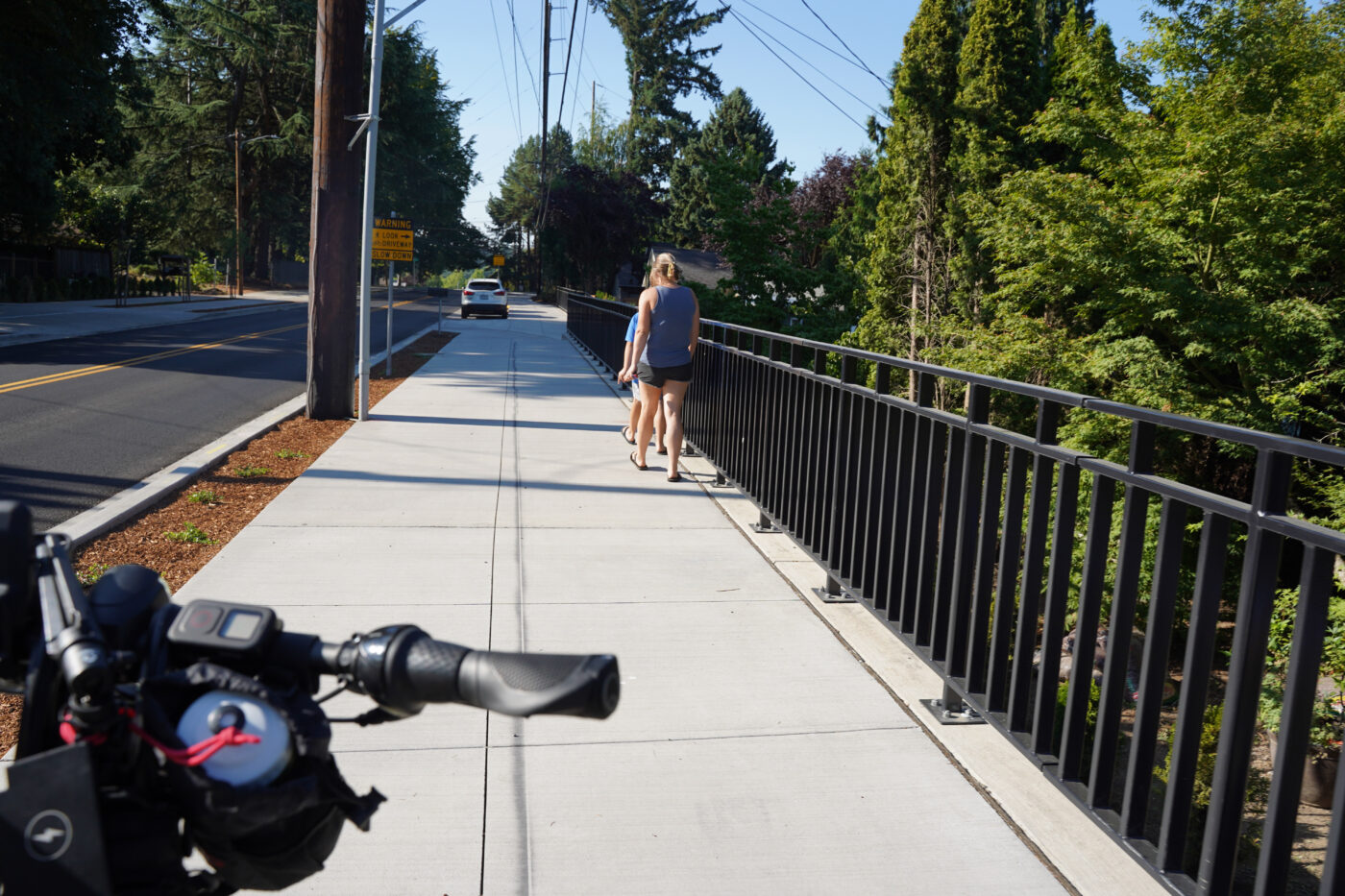

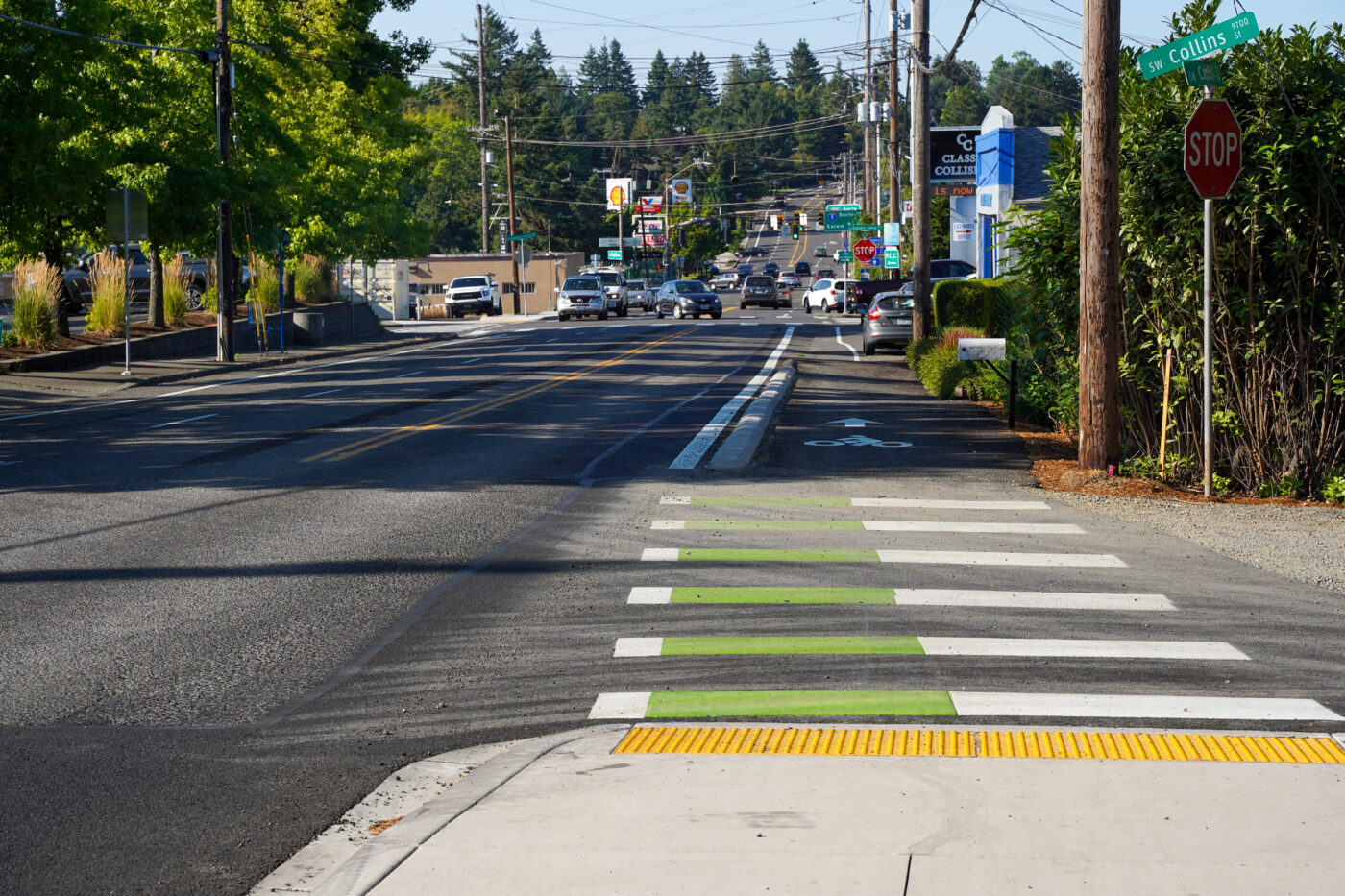


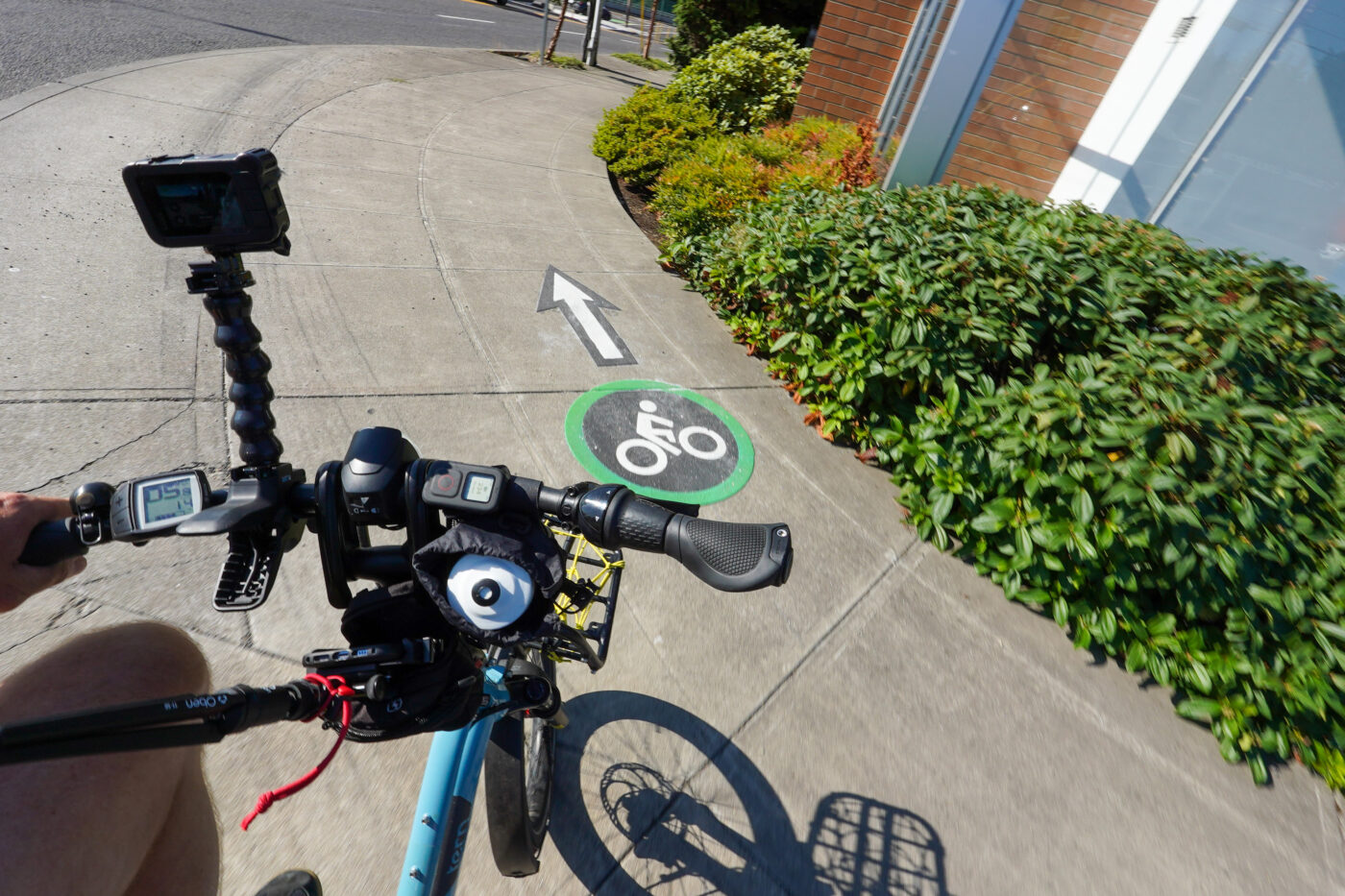
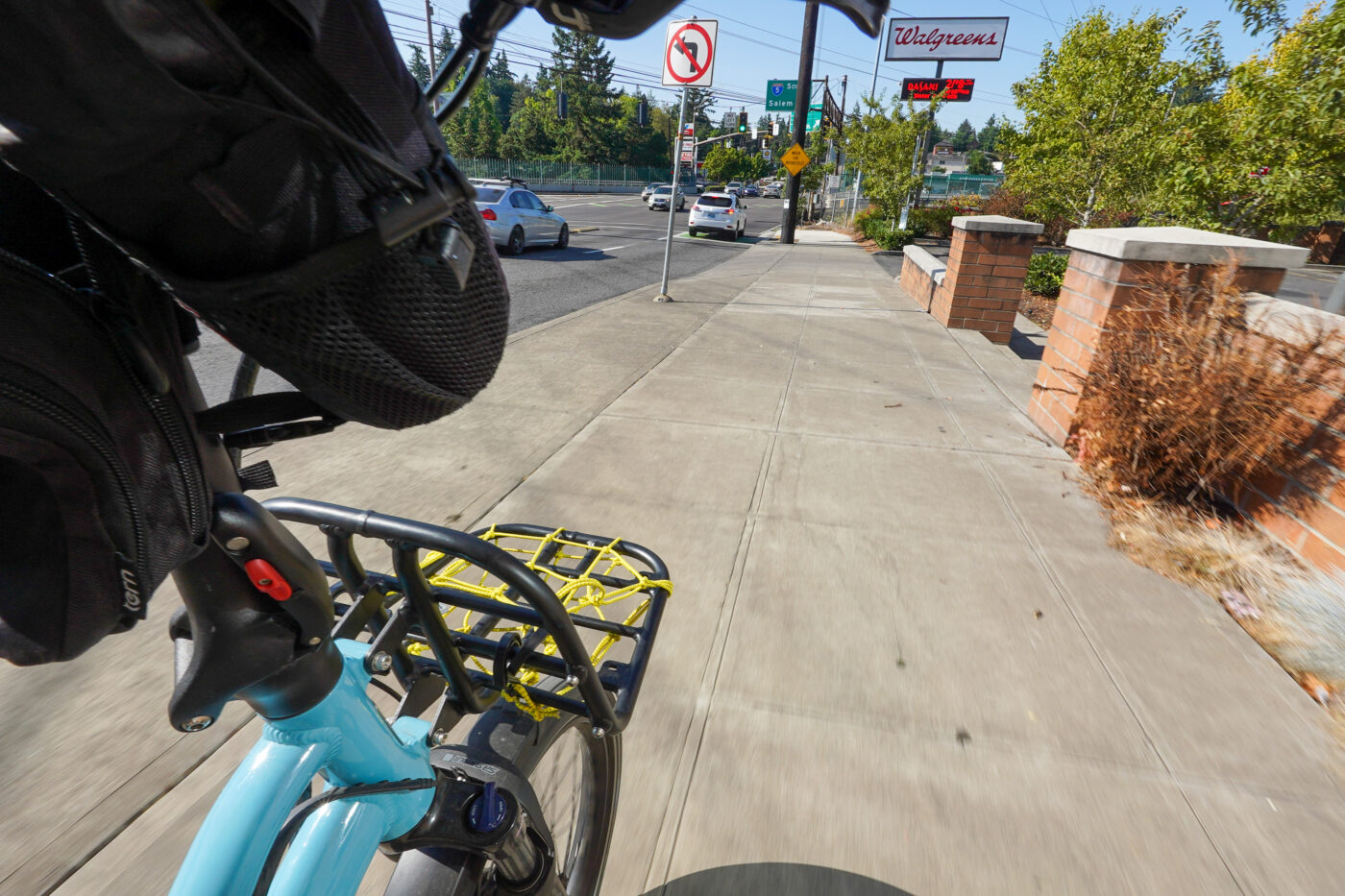
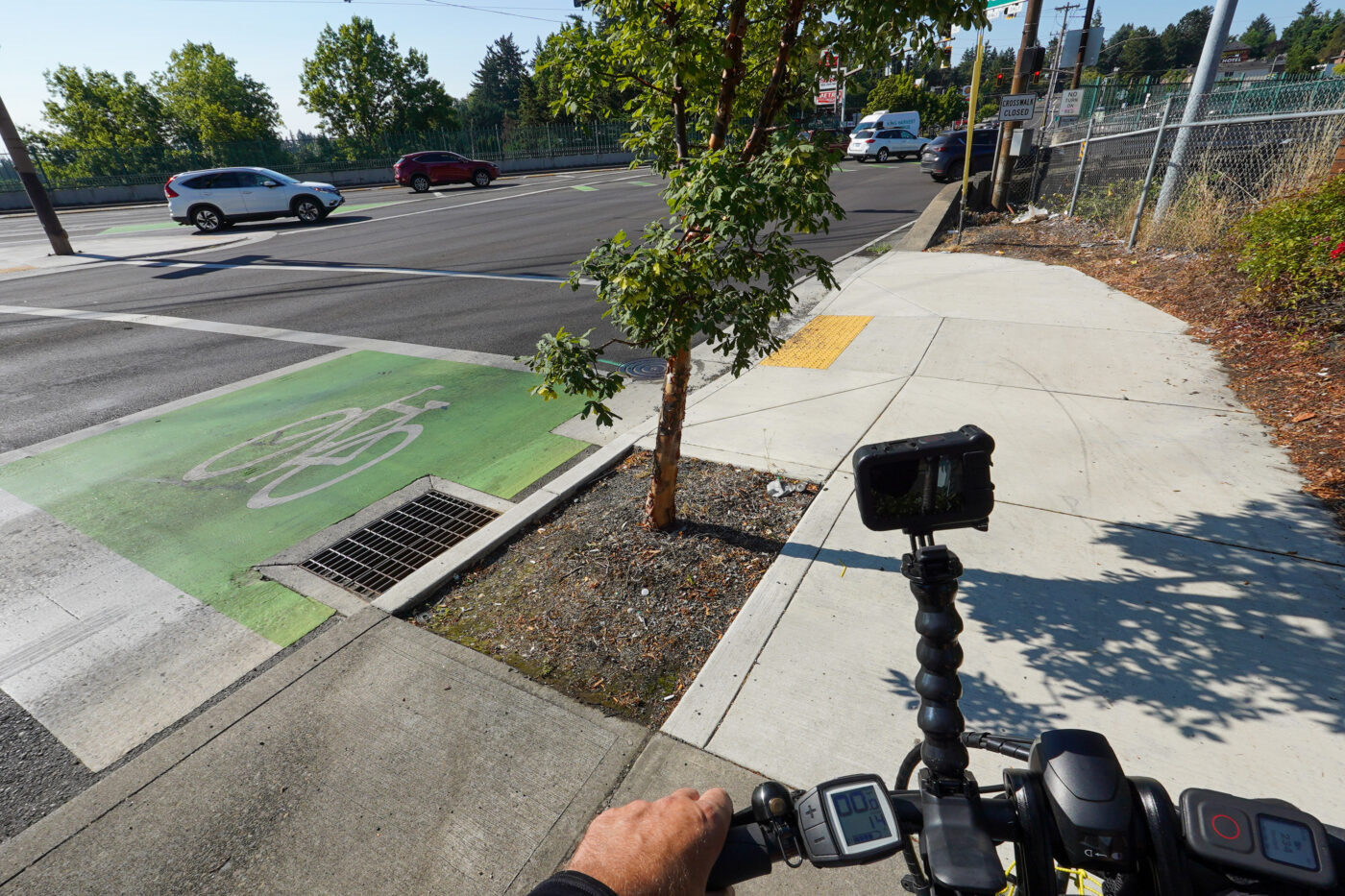
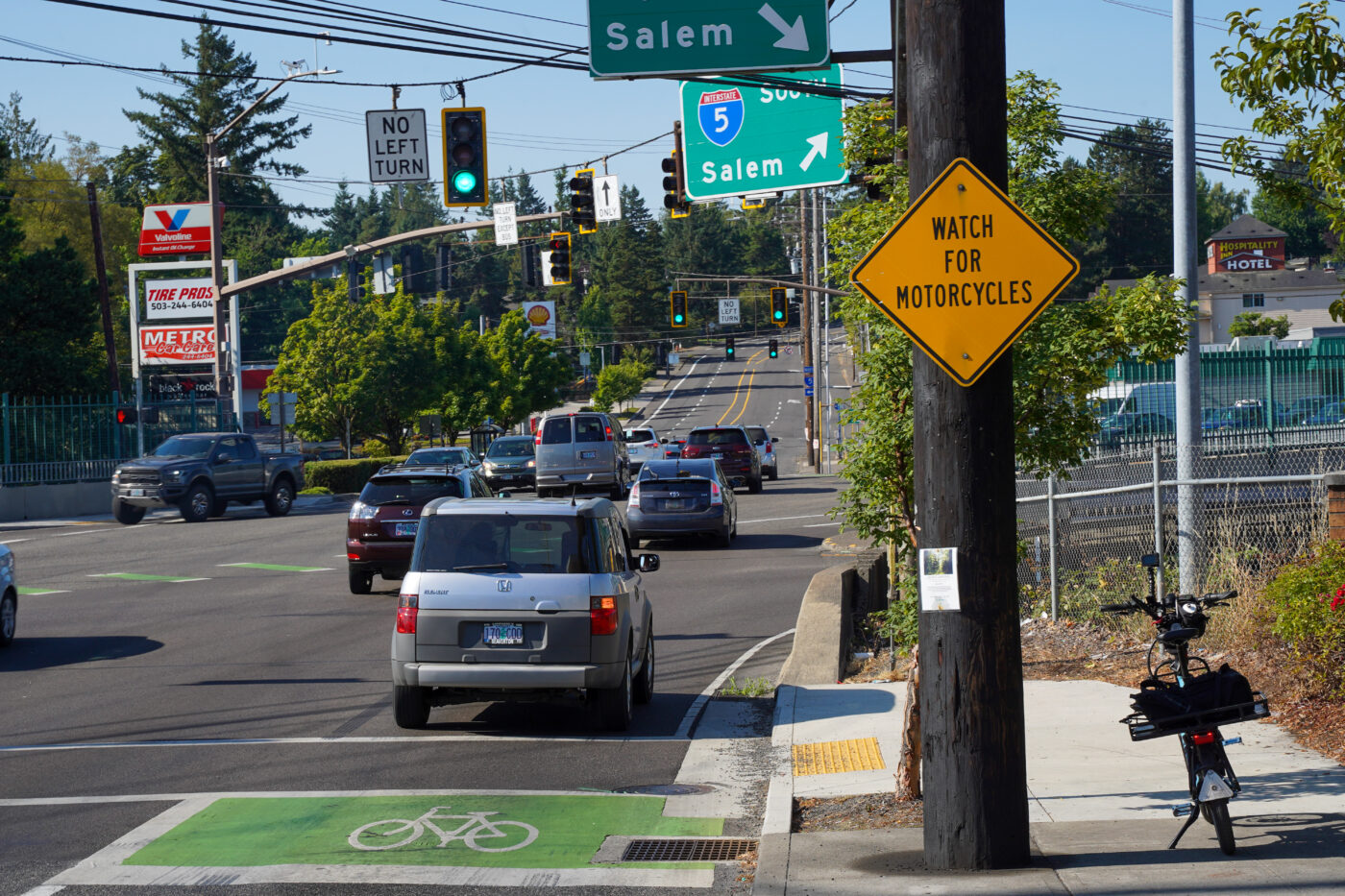
This is some of Portland’s best work. Besides the cross-bureau collaboration it took to make this happen, the street itself looks and feels really good. At quick glance, the non-driving space is about as wide as the driving space. That’s a great sign that people will feel comfortable walking and biking.
The biking space feels more like a sidewalk than I prefer. It’s separated from the street by a curb, which is great, but the concrete material is indistinguishable from the sidewalk and the bikeway. PBOT is still in the process of laying down a dividing line stripe which should help a bit, but I’d love to see more use of different colors to mark vehicle spaces (which bike lanes are) from walking spaces. (It’s also notable that the concept drawings on PBOT’s website show the bike lane a different color than the sidewalk.).
The bikeway itself is intuitive to use and feels very safe. Because the street is only one lane of car drivers in each direction and the speed limit is just 25 mph, the overall riding environment is pleasant and calm.
The bikeway crosses a ton of residential driveways. This might not end up being an issue, but any time you have people backing out with their cars over a bikeway, bad things can happen. The fact that PBOT has installed a bunch of yellow caution signs saying, “Warning Look Driveway Slow Down” makes me think they are concerned about this too.

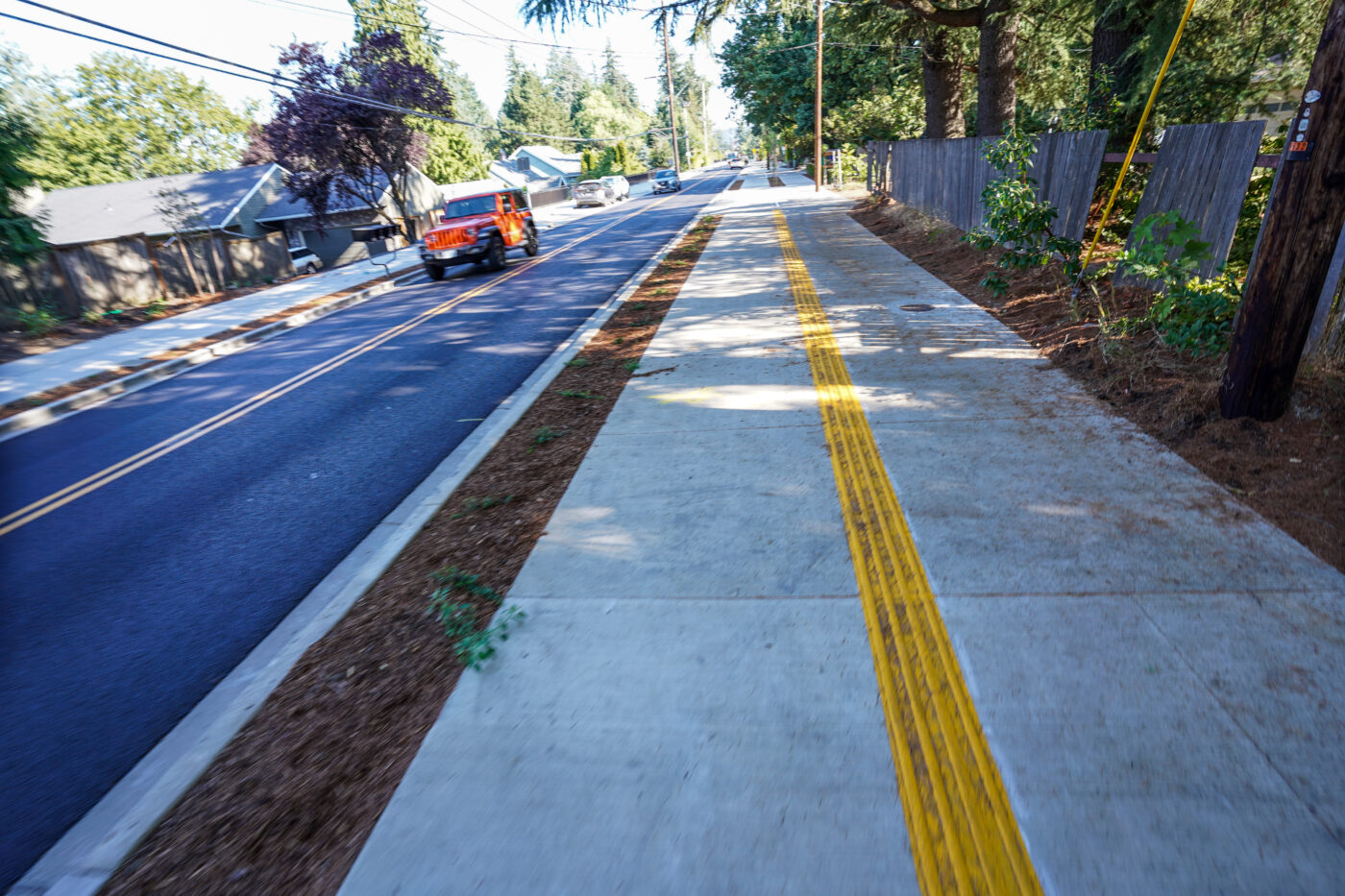

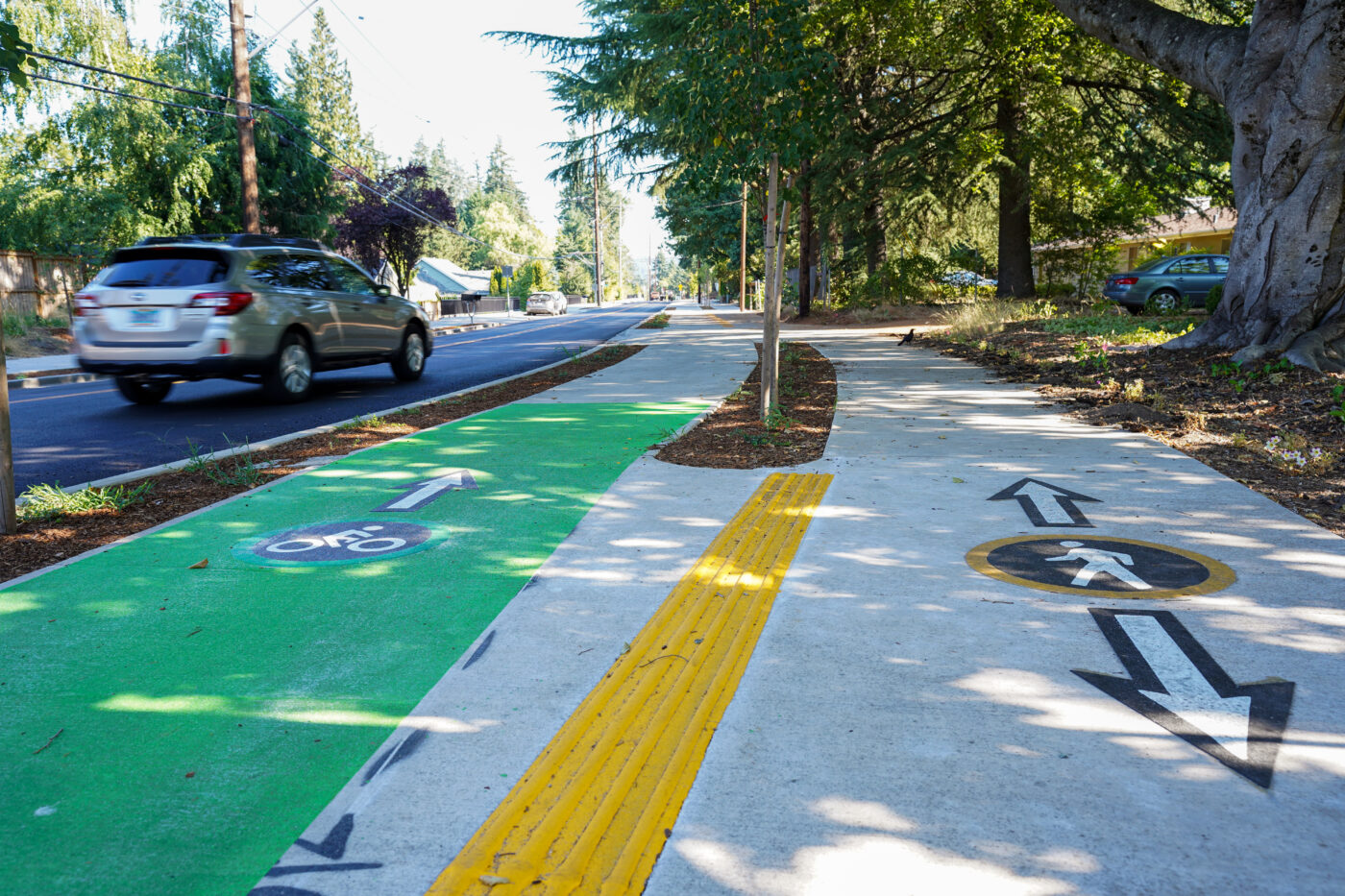
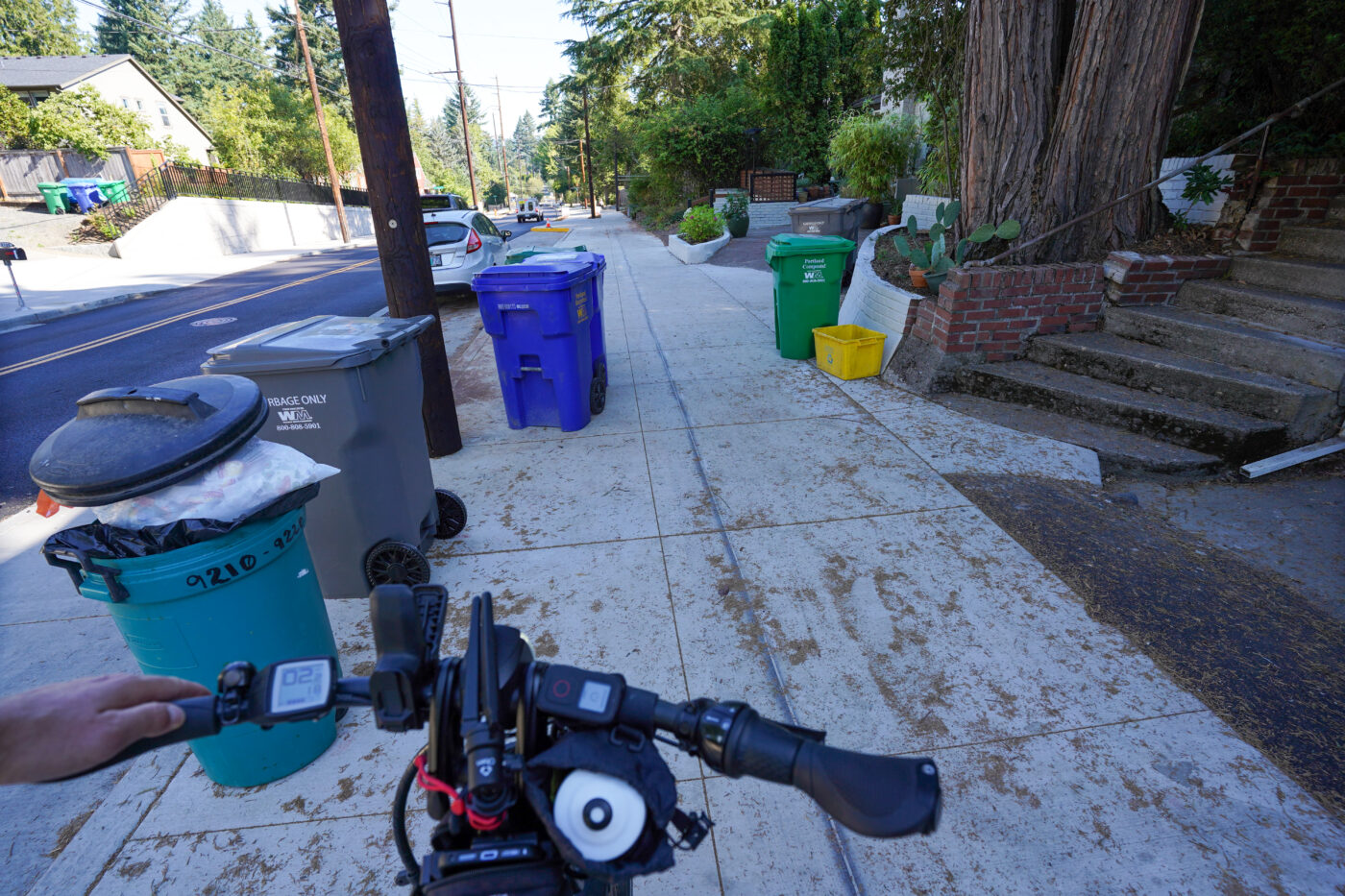
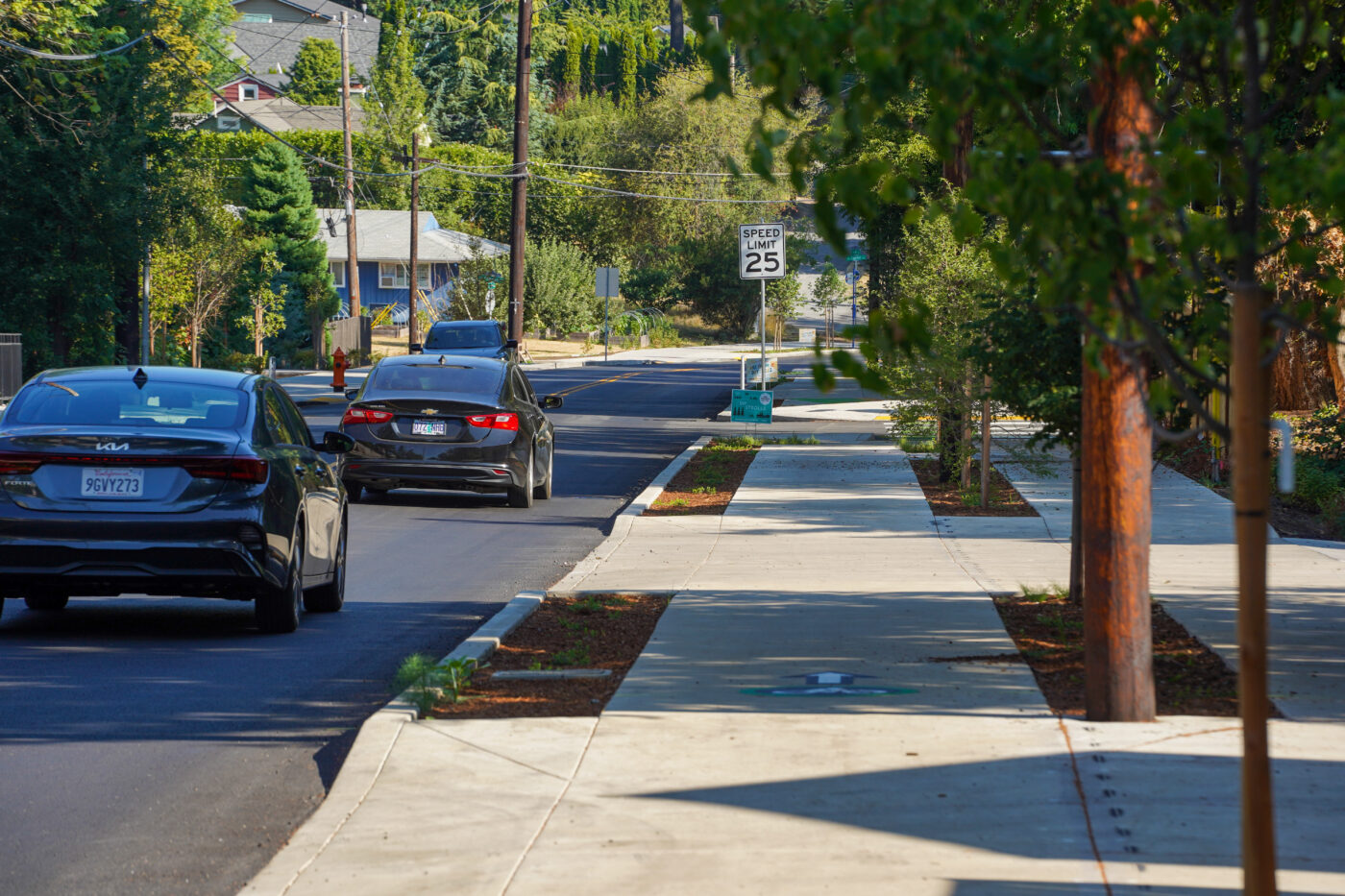



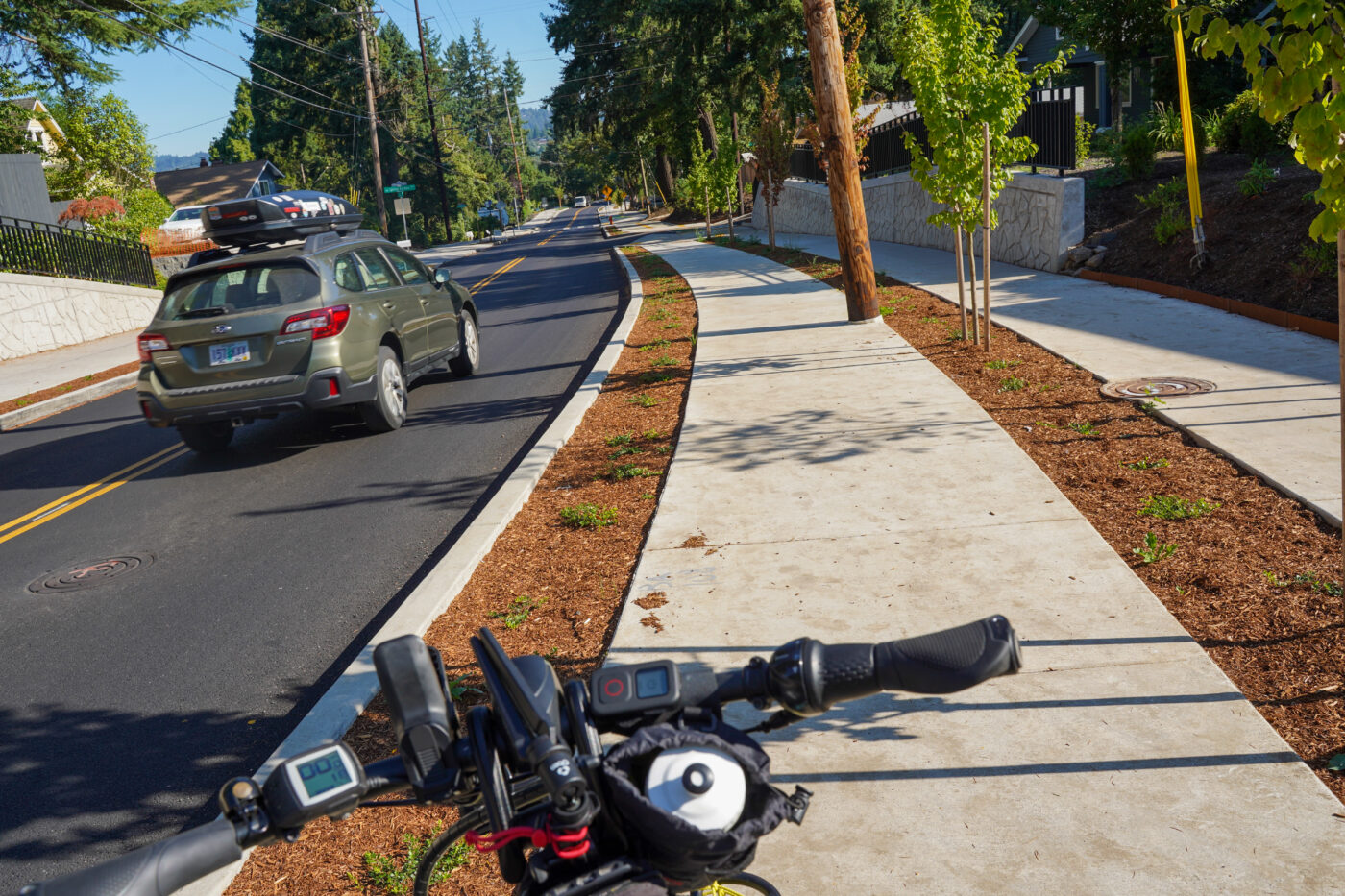
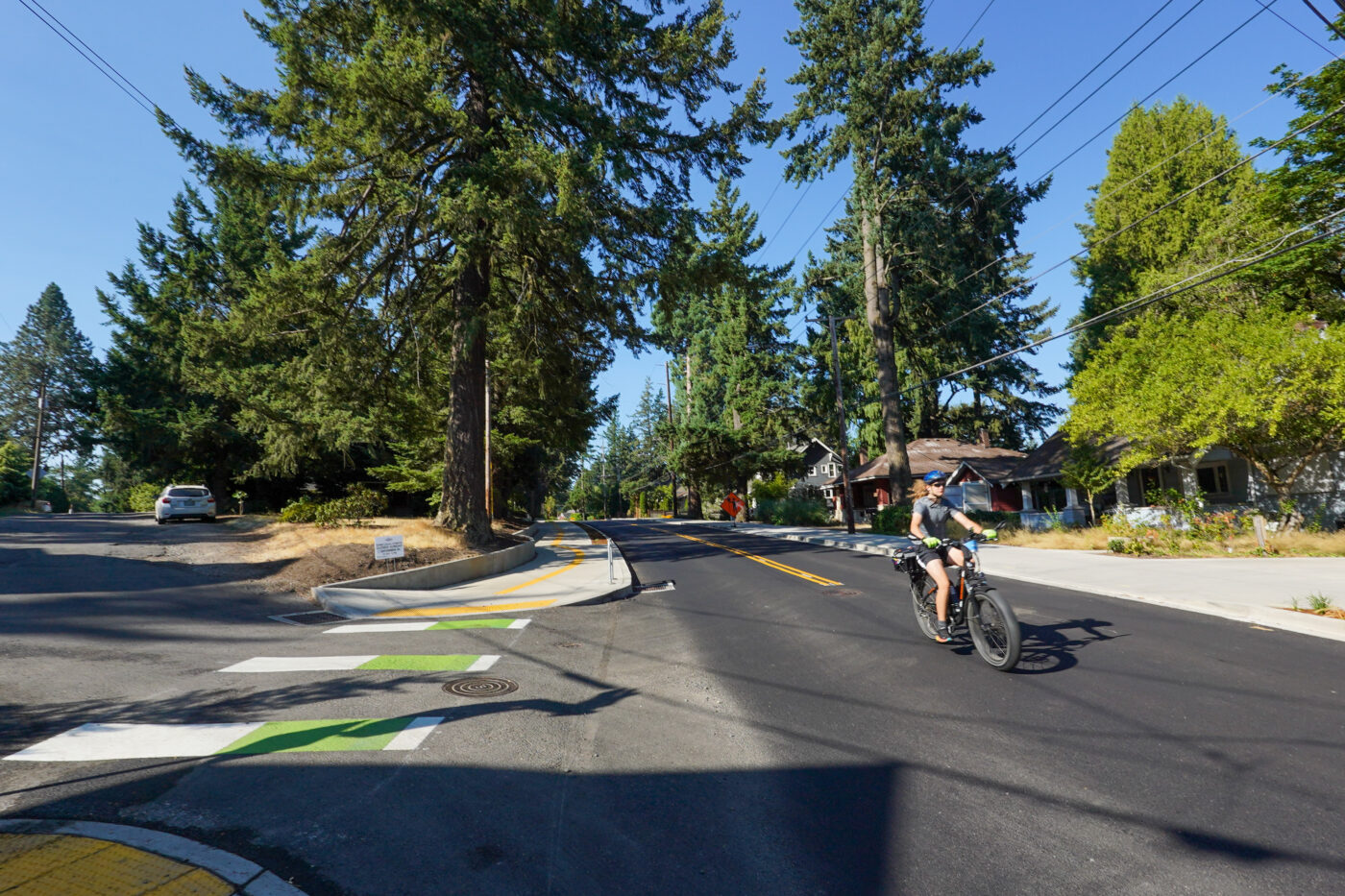
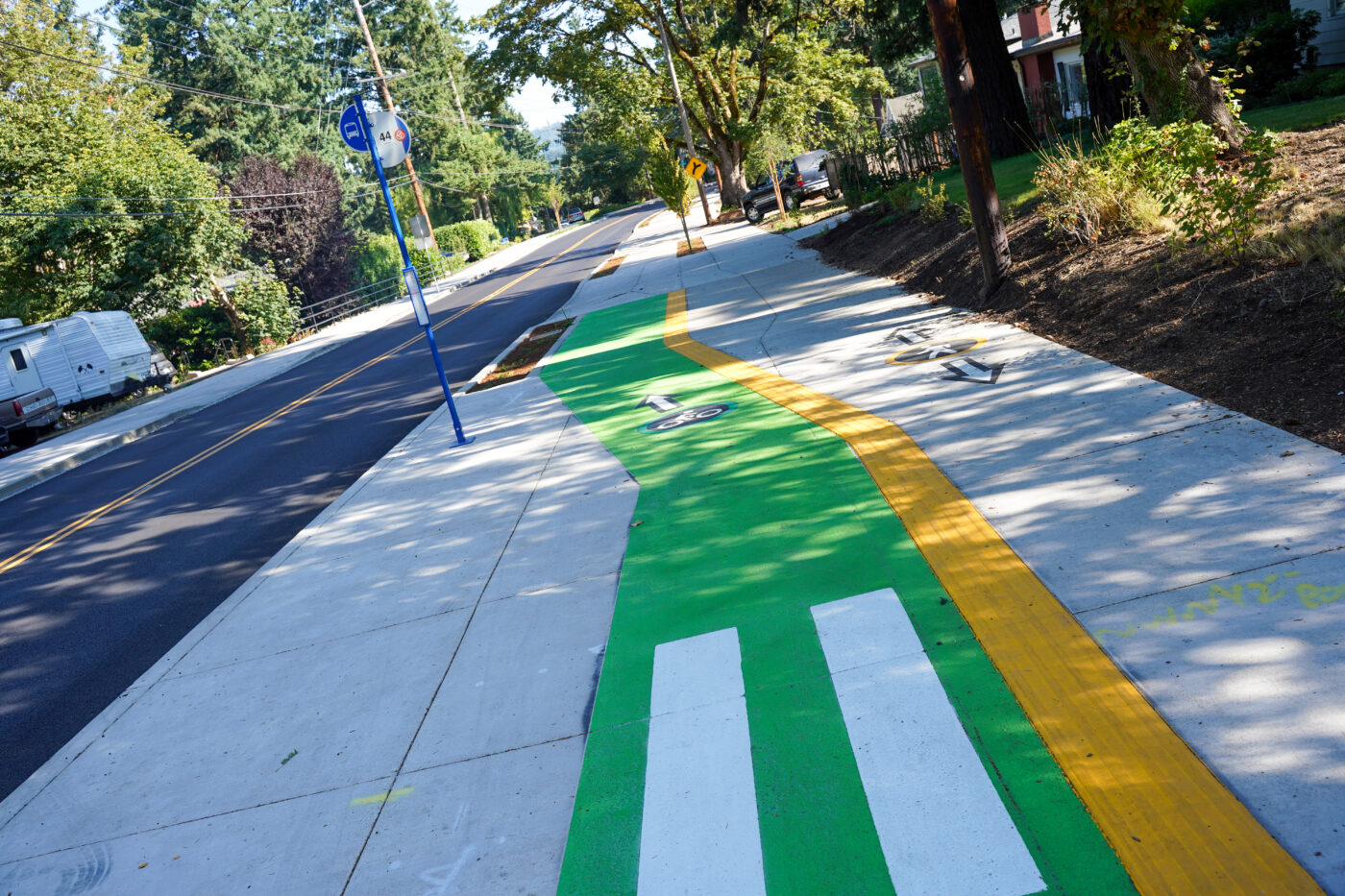

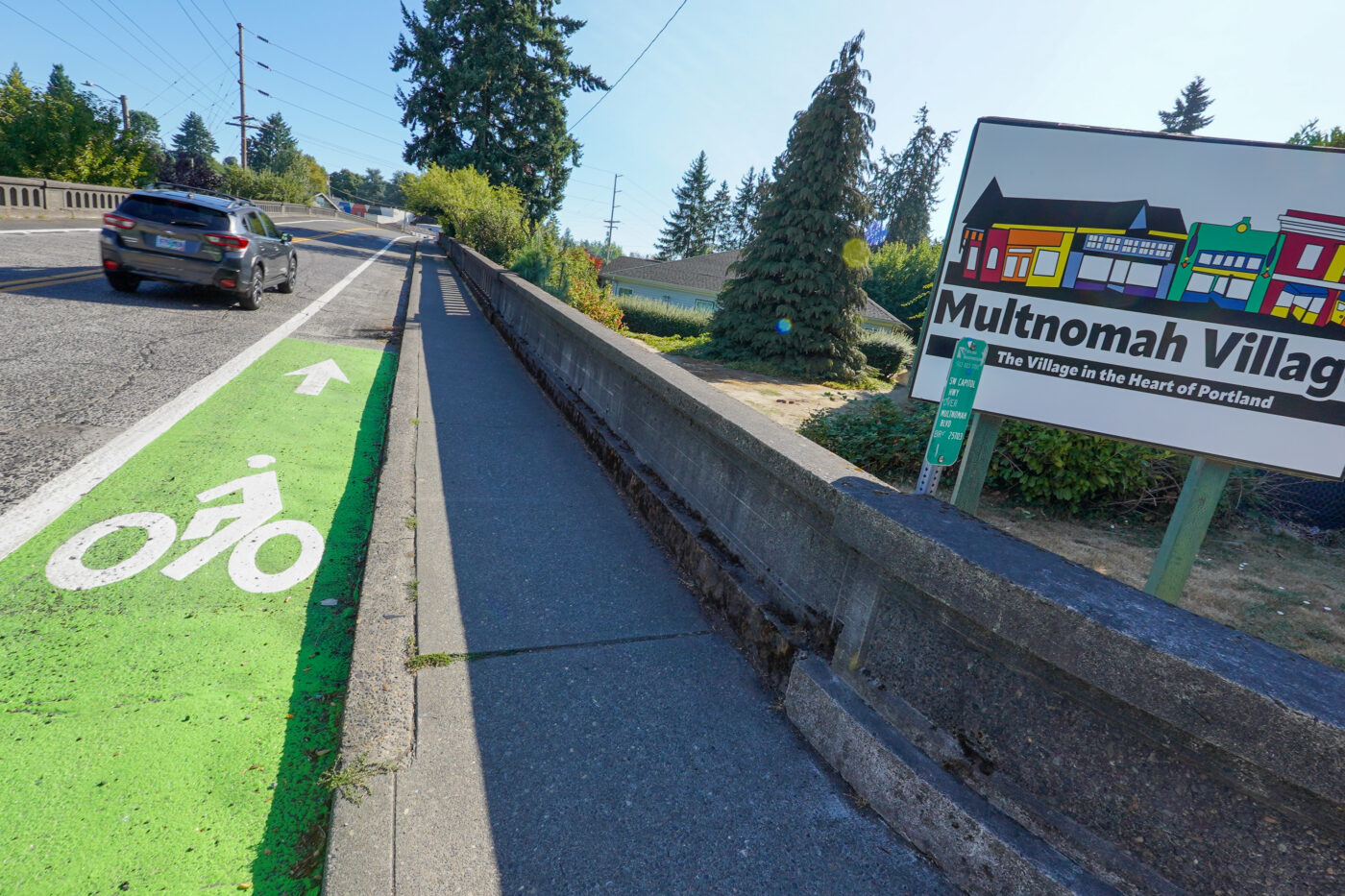
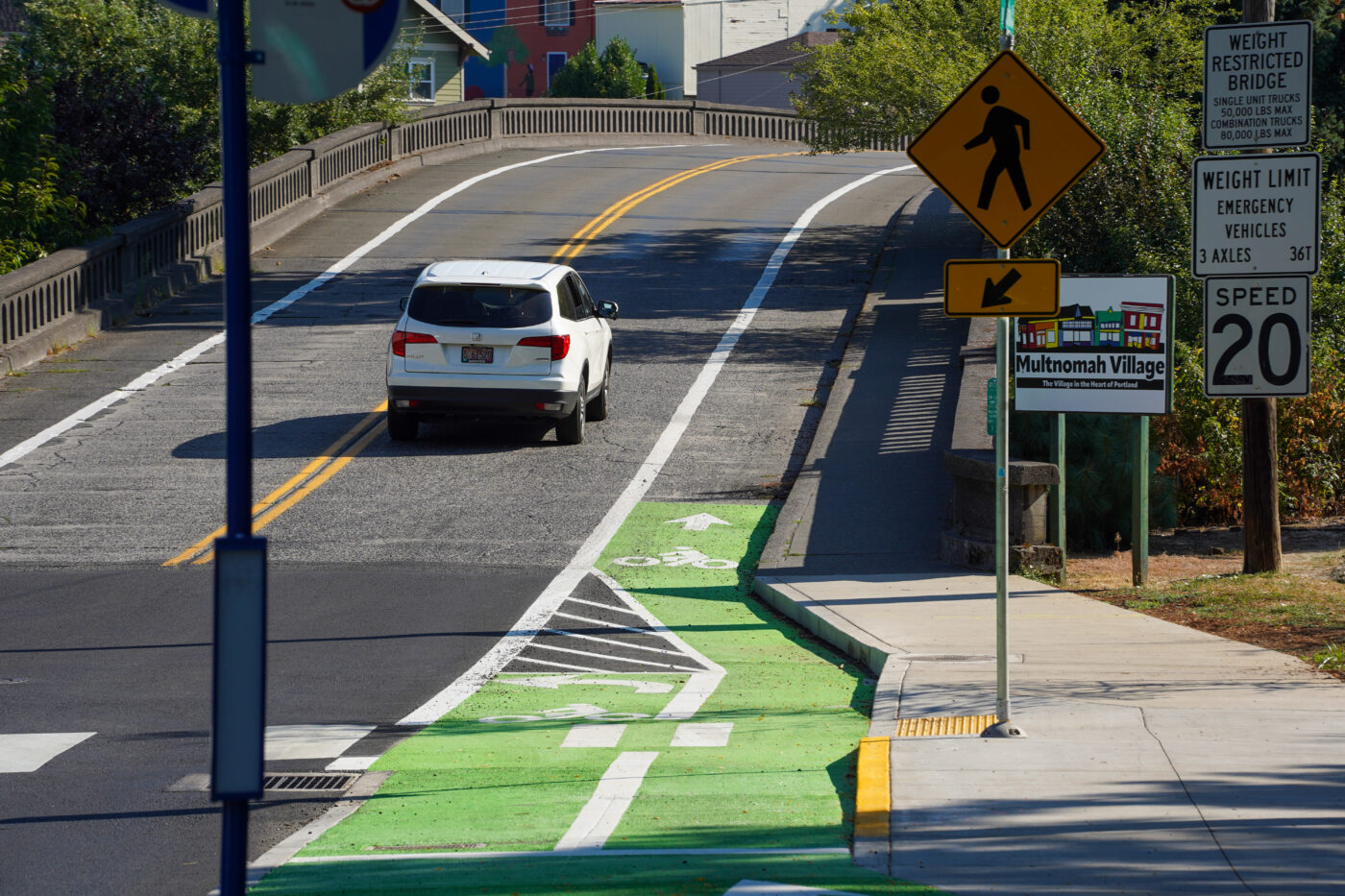
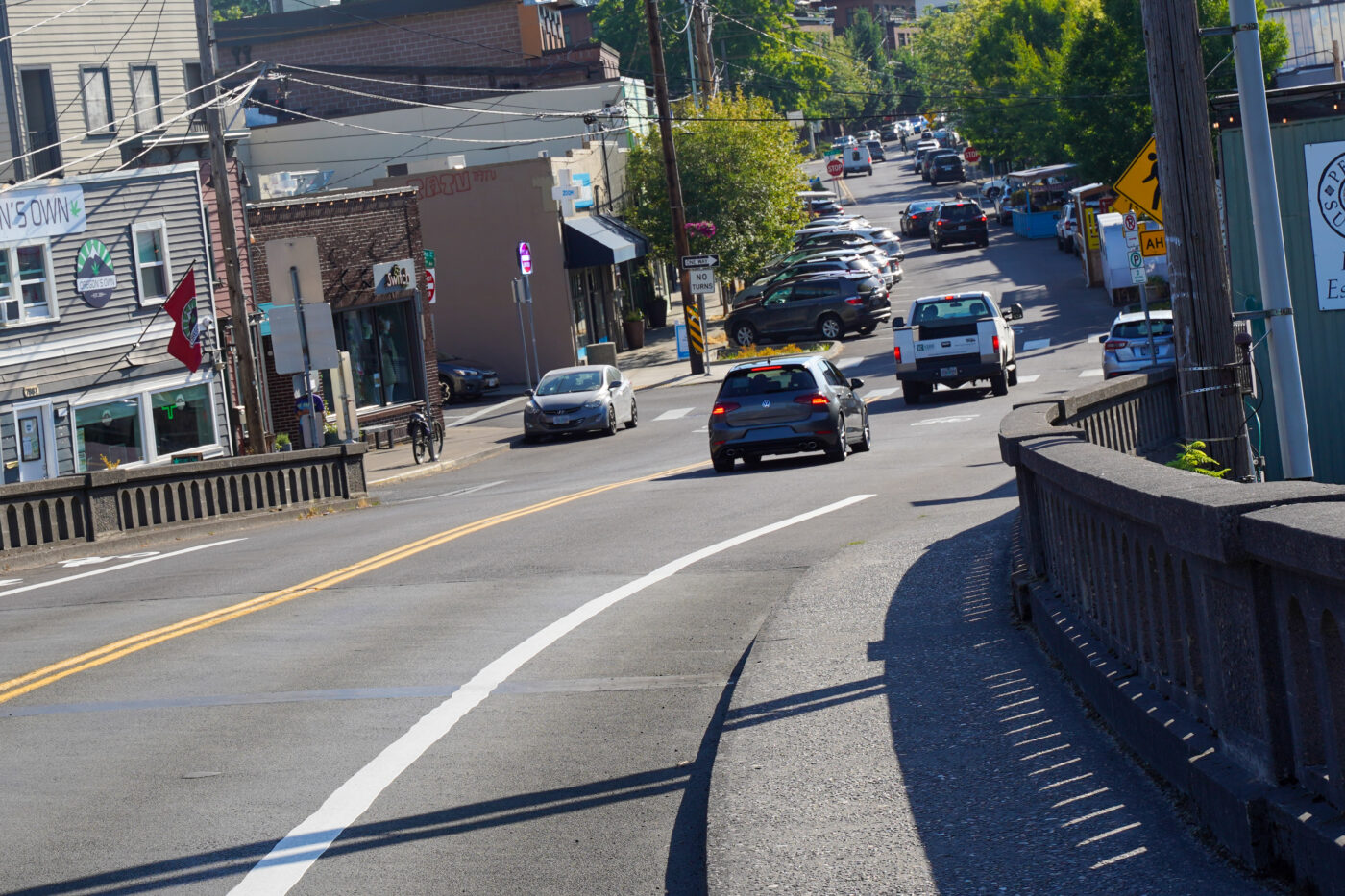
The southbound bikeway is very slightly uphill, so it’s not as wide and has less separation from pedestrians than the northbound (downhill) side. In some spots, both sides feel a bit cramped. If we ever have the type of bike mode share we all expect and dream about, facilities like this will be very tight.
I saw only three bike riders the entire time I was out there (on a sunny, pleasant, weekday morning) and they were all on e-bikes and they were all taking the lane (not even using the new bikeways).
This project is a godsend for runners and walkers! What an amazing new facility for nearby residents.
On both ends of the project, I was sad to see the same thing our bike network suffers from almost everywhere else: the protected environment erodes quickly into narrow, unprotected bike lanes and then drops to nothing right when all the good destinations appear. On the Multnomah Village side, the project dumps riders onto a narrow, paint-only bike lane (that was full of gravel) as it descends into the shops and cafes where it them becomes a shared-lane environment.
At least on the Village end, the street is chill and calm. But on the south side, the project comes to a very ignominious end. In a matter of a few hundred yards, you go from: off-street protected bikeway, to on-street, curb-protected bike lane; then to painted, unprotected bike lane; and then you are discarded into a narrow crossing of a slip lane before being directed onto a narrow sidewalk. Then you come to SW Barbur and I-5 on-ramps where they’ve installed a teeny-tiny bike box. I shudder to think what some folks will do when they reach this point. It takes a big leap of faith to continue southbound to the other side of the freeway.
Overall, this project is a huge step forward for southwest Portland and our bike network in general. It’s a demonstration of what’s possible when the City puts their best foot forward and builds “8-80” all ages bike facilities. I just wish projects like this didn’t take so long to get built. And I wish they connected directly to other bikeways of similar quality.
As it is, with its limited connections and the overall lack of bike-friendly routes in this area, I just hope enough people ride it to solidify the “built it and they will come” narrative that is likely to be increasingly scrutinized in political debates in the months and years to come.
NOTE: I forgot to switch the banner in the second half of the video. Sorry for any confusion.



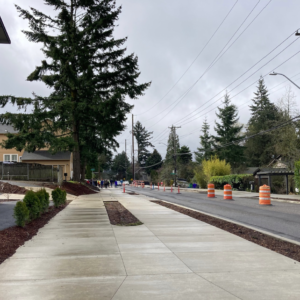
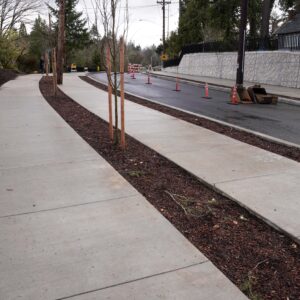


Thanks for reading.
BikePortland has served this community with independent community journalism since 2005. We rely on subscriptions from readers like you to survive. Your financial support is vital in keeping this valuable resource alive and well.
Please subscribe today to strengthen and expand our work.
Overall I’d say this project is a success. The car lanes feel small and so people are driving reasonable speeds on them. When I was on it the other day, I saw people walking, people biking with children and even a cargo bike with a child on the back. That didn’t exist here before that project and doesn’t exist much elsewhere in SW. There is demand for more all ages and abilities bike infra and I hope the lack of connections doesn’t take away the opportunity to extend this network in the future.
My biggest complaint (other than telephone poles being in the middle of the bike lane which I’m glad to hear from Stephen that they will “eventually” be removed), is the position of the curb cuts in respect to the bike lanes. If you don’t make the sharp turn to align with the curb cut, you are going off the curb. Look at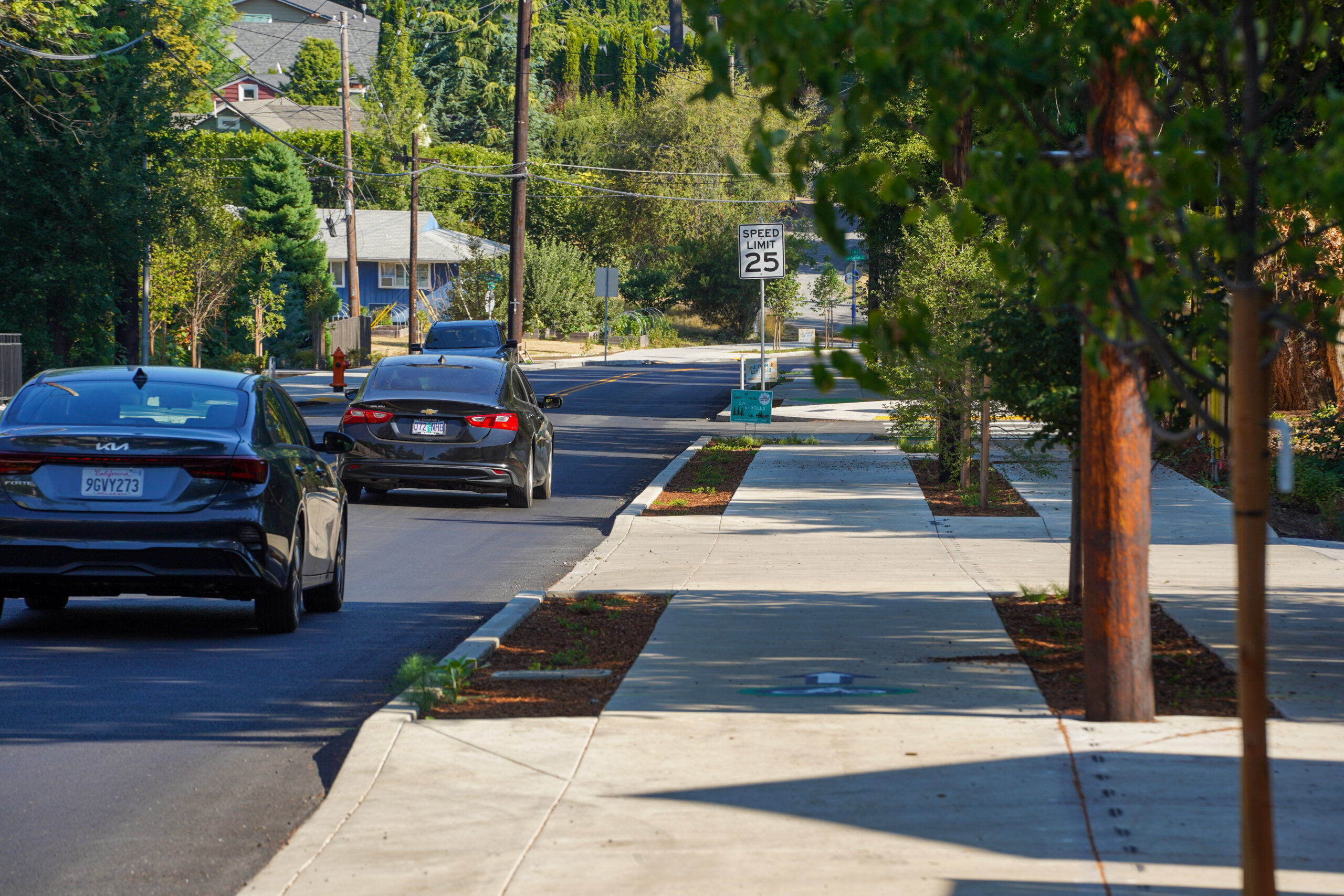 , can you tell that you will have to swerve to not go off the curb? what about when it is dark and rainy? Someone is going to crash here.
, can you tell that you will have to swerve to not go off the curb? what about when it is dark and rainy? Someone is going to crash here.
These “accessible” curb ramps are terrible, and a huge missed opportunity to build the crosswalk & bike path at a continuous grade through the intersection. This would more effectively slow down turning cars and improve pedestrian & cyclist comfort:
https://www.cnu.org/publicsquare/2021/07/29/where-sidewalks-and-bike-paths-have-priority
NJB as usual has a good video on these “continuous sidewalks”:
Crossing the Street Shouldn’t Be Deadly (But It Is) https://www.youtube.com/watch?v=_ByEBjf9ktY&t=746s&ab_channel=NotJustBikes
I assume our division of street maintenance and stormwater management into separate bureaucratic silos is partly to blame here, since storm drains would probably have to have been moved away from the corners to allow for a raised crosswalk.
I like it, but it also illustrates that the difference between riding your bike on the sidewalk and “shared ped/bike facilities” is that there is paint that says bikes can be here. That may be a wider sidewalk than needed for just pedestrians, but not by much. That just looks like a sidewalk! That can be spun positively in that anywhere we have a sidewalk, if it’s at least that wide, just call it ped/bike and expect bikes.
When I used to live in that area, I commuted to downtown and this section was on my route, so I would have used this every day if it existed. Would have been much appreciated, as this was the main sketchy part of my ride. That, and the part where capitol highway turns into that ramp to merge onto Barbur after Hillsdale, but that was just fun for me, I liked recklessly going 35 with traffic. Not for everyone.
I’ve ridden this a few times, and have mixed feelings. It’s obviously a huge improvement from the prior conditions especially for pedestrians, and it’s more or less well thought out. I love sidewalk level bike infrastructure! But projects like these do make me wonder if anyone at PBOT is really riding a lot. Sidewalk level bike infrastructure is nice, but the sidewalk-style paving rather than road-style paving is definitely a miss, and a fairly obvious one at that. I’ve never met a single person who rides a bike who would recommend that. Plus, the cycletrack crosses all of the curb cuts (and there are many) fairly close to street level which makes for a fair amount of up-down movement. Some of these up-down jogs mix in with awkwardly placed utility poles which make the experience mildly annoying. I imagine in wet conditions it would make it mildly sketchy – which isn’t something we need on newly built infra.
All that said, it’s a big improvement from the prior conditions, but still lacks the sort of intuitive useful connections that are desperately needed in so many places in SW it’s hard to imagine this moving the needle appreciably. I’d say at minimum, this needs a more direct connection with the pretty good cycletrack on Multnomah Blvd (which in turn needs a better connection towards downtown than the I-5 off ramp to Terwilliger) and a safer crossing of Barbur/that I5 exit to really feel like anything other than a nice piece of bikeway in no mans land.
Kachunk, kachunk, kachunk, kachunk, …
The Linwood Avenue Improvements project in Clackamas strikes a nice balance of smooth asphalt alternating with concrete driveways:
https://www.clackamas.us/development/linwood-avenue-improvements
Indeed! The city of Milwaukie already completed their portion of Linwood avenue a year or two ago so you can ride it now. The bumps at all the driveways are a little annoying, but like this Capitol Highway project, it is still a huge improvement!
I think someone mentioned that about the sidewalk style paving last time this path was written about on BP. I just wonder, what are you riding, or what do you think is an alternative? Asphalt? I don’t want yet another head-island exacerbating piece of black asphalt to ride on. I don’t know any other type of finished surface that exists that wouldn’t have those joints. Maybe I’m just blanking on something obvious.
Can you really feel the tiny bumps between the sections? Maybe I’m just feeling newly superior because I ride around on cushy 47mm tires now, but those feel smooth as glass compared to even a mild crack on a piece of asphalt. You don’t know me, but I’ll put my hand up as a person who likes that style.
Unless you’re talking about something completely different, in which case I’ll delete my account.
Yes. They’re not always so tiny. I ride a typical urban commuter bike, with tire pressure around 80psi.
Asphalt (or continuous concrete) is far more pleasant to ride on (and helps with separation from pedestrians). If you’re concerned with heat, shade it with trees. Lots of trees. You know, the kind Portland keeps removing and letting people cut down.
I mean what’s wrong with whatever surfacing they use on like the Springwater Corridor? Doesn’t have to be like pitch black. And concerning heat island, having lots of trees is still probably the best way to combat that, rather than using sidewalk pavers for bike infrastructure.
My widest tires are 38s and I can definitely feel it when I ride on the sidewalk pavers. It’s annoying and pointless in my book, and you are the first person I’ve ever interacted with who prefers it.
I don’t know, any time I ride on asphalt on a hot day like the last few, I can feel the hot sun almost as much from the radiation off the ground as from the direct sun. It’s hot! The springwater in particular is hot. Even if it doesn’t contribute that much to the heat island, it’s still personally uncomfortable. I guess if you can put something on top of it that isn’t dark black, but I haven’t seen a lot of that.
I can see with age, the sidewalk surface will shift and get hard ridges. If they’re bad enough, which usually takes decades, that can be a problem. But until then, I just don’t get it. I did some riding today on some empty sidewalks for comparison. Feels fine to me. But I keep my tires inflated to the minimum after learning how little an impact that has on speed. 40psi on 47mm. Feels like riding on a cloud.
Just in case you or someone else didn’t know, but those joints aren’t pointless, they reduce further cracking and degradation of the sidewalk. Watts mentioned “continuous concrete” and if that’s a thing, I don’t know why they don’t do that in any sidewalk I’ve ever seen.
I think it’s really clear why ebikes were still in the road, despite the law to use bike facilities where available. This still “feels” like a sidewalk to them. You’re not going to feel like going 15-20 mph on a sidewalk, let alone 25-28 mph, even an empty one because it’s not wide enough and those cracks, when they’re disturbed by tree branches, freeze thaws, soil settling, etc. cause shifting which leads to major height hazards (maybe this is fine for now but a crack in asphalt just breaks down but concrete sidewalks tend to all slant together and soil settles…). I’m glad they’re building out facilities that make biking a lot more welcoming for all ages–don’t get me wrong–and I don’t want perfection to be the enemy of the good but I’m not sure an extra wide sidewalk is the right approach.
Seattle has the Burke Gilman where you have stretches by business, the university, etc. that are dark asphalt next to sidewalks for pedestrians. This makes it very clear to pedestrians, who are more prone to meandering and distractions (phones, headphones, etc.) where they’re meant to walk. This area may not have been wide enough to do that but I suspect this will probably be done in the next iteration because people will realize it’s worth it to have clear boundaries. Or, like the Dutch, you have stamped concrete like pavers so you get a clear visual difference. It’s worth the cost because paint alone doesn’t work and shouldn’t be considered infrastructure. Other areas in Seattle are putting protected bike lanes in similar neighborhood, even ones that cross driveways. Maybe that would have been better. Sidewalks might feel safer to few cyclists and city planners that don’t ride but I don’t really think they are…
Good points, E. I’m just waiting for the first fast downhill cyclist to be taken out by a car or dog or whatever on that tiny sidewalk. Really we should have a regular bike lane downhill and not force everyone to ride in a space that is right for eight-year-olds and their moms.
Everyone else should continue to take the downhill lane.
Another good argument against requiring people to ride in the bike facility. It reminds me of a comment in another recent article about the danger of riding in a bike lane that puts you in the door zone, especially when passing a car with large doors and tinted windows.
In both cases, it’s not a matter of a facility that would typically work for bike riders, but happens to be temporarily unusable/unsafe due to a temporary problem like a parked car blocking it.
Instead, both are regularly problematic to use, without anything unusual happening–this one because it mixes downhill riding with slow and unpredictable sidewalk users on a narrow path, and the door-zone ones because they put riders so close to parked cars that each parked car is a potential danger.
If a bike rider told a cop they had to ride in the lane because there was dumpster blocking the bike lane, they’d be believed. If they said it was because they were trying to avoid riding past people walking dogs, or past parked cars, they might not be believed.
I wonder if this counts as a sidepath. I would argue it has all the hallmarks of a sidewalk (which cyclists are not required to use), especially given those signs that Trike Guy suggests reference ORS 814.410. If the facility was a true bike lane, you wouldn’t need to slow at crossings.
I fear this, like the “bikewalks” before them, a case where PBOT is creating legal ambiguity and hence safety issues with its designs.
I haven’t ridden this facility yet, so everything I know is based of what I’ve read here, but it sounds like things would have been better with a more conventional street-level bike lane design. That would be less appropriate for the mythical “8-80” crowd, but it seems that at least some cyclists are frustrated at the slow, 8-80 nature of this facility.
When I ride it, I tend to take the separated sidewalk on the uphill and the lane on the downhill. Not too hard to go near 25 MPH on the downhill.
So by law bikes have to ride on the path. But there is no legal requirement that pedestrians stay off the bike path. Seems like accident waiting to happen.
Porous concrete is great to ride on- check out the MUP along the river on Swan Island south of the Daimler HQ. (I know it does live up to the permeability hype w/o being vacuumed, I am just talking about rollability)
I will. Looking on the map though, where does that go? It looks like it’s tricky to get to it and it goes nowhere. Maybe it’s just a nice place to go for a walk if you work there. And FWIW, I can see the expansion joints from satellite, so I’m not sure my poor butt can take it.
It is interesting to see so much discussion about the feeling of the concrete expansion joints, when the dips for the driveway curb cuts are much worse IMO. There must be some regulatory snafu going on there, you can see the same extremely uncomfortable dips on the SW Vermont between 50th and 52nd. I feel like cars don’t need that generous of a grade to enter the roadway. I mean – look at the grade the driveways have to their homes – it is much more severe and irregular than when they have to enter the roadway.
The core issue is whatever regulatory body decided it was okay to have driveways off of a road. Streets – okay, those are local access only and are typically designed to not have much traffic. But it is simply bad planning to have a throughway with driveways off of it – and we see it all over the USA. They used to have back alleyways to address this problem, but at some point some idiot decided those weren’t necessary for whatever reason. I can only assume drugs were involved.
Yeah, the concrete really is no big deal. Sure I notice them on my 28mm tires, but it isn’t all that noticeable. I haven’t heard any complaints about the Moody ave sidewalk level bike lanes because they are straight, level, wide, and clearly delineated from the sidewalk so encounters with pedestrians is rare. Capitol highway is none of that.
Yeah the driveway cuts really are bad, but I think they are made much worse by the interaction with the sidewalk style paving. The up/down from the cut mixed with the bumps from the sidewalk is a dangerous feeling combination, especially going at speed downhill.
And concerning the curb cuts on throughways, I don’t really think that’s a uniquely US phenomena. Here’s a random bit of the A202 in London that has a bunch of curb cuts for driveways. And here’s the A6 in Manchester. Things like this are far less common in France, though suburban Paris has a few examples as well. Here is an example from Tokyo. In general, Latin America seems to have far less – owing to their love of boulevards (the Netherlands as well).
It’s interesting that you bring up alleys as well, but most places didn’t get rid of them rather they just never had them for one reason or another. So Chicago by and large has alleys because they thought it’d be a good idea in the 1850s, whereas New York doesn’t because they were not apart of the originally platted street grid. Evidently, Chicago is much cleaner than NYC in some part because of Chicago’s use of alleys for trash and such but that’s a bit beside the point. You will certainly see more curb cuts in Manhattan than you will in Chicago as well.
At various points in time, alleys were considered to be seedy and/or dangerous and have fallen in and out of favor depending on factors beyond what I could tell you. But apparently, very few alleys have been constructed in the US post-war, so maybe this all was a long-winded way of agreeing with you.
Thank you for the examples of stroads around the world. It is somehow comforting to see these mistakes occur elsewhere; at least we were not unique in our stupidity. I note that none of your examples show grade separated infrastructure. All of the examples that had cycling infrastructure shared the roadway with the cars at the same grade.
When I think about examples of an throughway that has separated cycle ways and lots of driveways, I think the best example I have personally seen is Jackson School in Hillsboro, but the cross section is about 20+ feet wider than the one for SW Capitol HWY. In this respect it seems like the design is quite novel.
I took the newborn and the toddler on on it to Spring Garden Park a couple weeks back from Tigard and had a great time. I wasn’t going very fast anyways, and the curb cutouts really aren’t a big deal when moving at slower speeds. Before this, I was unable to make this trip due to my desires to not expose my children to that level of traffic stress. Now I could. So, massive success. The curb cutouts are nitpicks, and speed is a luxury.
“a bunch of yellow caution signs saying, “Warning Look Driveway Slow Down”
I’ve never understood this… what signage do the folks in cars backing out of their driveways get?
Am I wrong or does the existing signage invert/confuse/misrepresent who actually has the right of way?
I always felt the same way about the initial caution signs along the 17th Ave bike route south of Sellwood. It inverts Oregon statutes and the responsibility of people driving to stop twice before exiting driveways: Drivers stop once at the sidewalk and once again before entering the roadway.
I think there is a deeper less here about Carhead.
El Biciclero would no doubt have some well-articulated thoughts on the subject.
I had the same thought, 9watts. None of the entering streets has a “Stop short for bicycles” sign, so you can guarantee some driver is going to take out a bike rider, esp on the downhill side.
Got dizzy watching it!
JM, I don’t understand why you didn’t call out the not one but TWO telephone poles DIRECTLY IN THE MIDDLE of the northbound (downhill) bike lane.
Also you should have visited on Monday morning, which is trash pick-up morning, when the bike lane is essentially unrideable thanks to all of the containers on the sidewalk.
Yes, it’s better than it was, by a long shot, but still it falls so far short of what we could have.
Apparently the utility poles will be moved by the electric company but they haven’t gotten around to it yet. (They obviously have no incentive or disincentive to do it this year or in a decade so don’t hold your breath.) At least that’s what PBOT told me when I suggested that they protect them like the field goal post at the back of an end zone. As they are now, definitely a hazard. Especially at night.
I think it’s absurd that they took so much space to put in those little street parking bays, right next to these house with huge garages and driveways.
Right? Amazon trucks can just park in those garages and driveways!
Or just stop on the side of the street? The traffic volumes aren’t so high that drivers can’t just go around. And with cars already parked in the bays, it’s not like Amazon/UPS/FedEx can park there anyway.
Yep, the parking should go. It just becomes free storage for locals’ third or fourth car.
Correction in the story body: It’s SW, not SE.
Wow that embarrassing. Thanks for telling me. Fixed it.
With a 25mph speed limit on the road and the “bike path” (wide sidewalk) being unsafe to ride at speed you can bet if I ever ride this I’ll take the lane downhill.
I don’t ride the downhill Sunnyside “bike lane” (I take Sunnybrook to 82ndthen up to Harmony/Sunnyside) or the south half of the 17th ave path for similar reasons – they aren’t actually properly designed for cyclists.
Those yellow caution signs do not invert Oregon law – they’re based directly on ORS 814.410 Section 1 – part of which requires cyclists on sidewalks to slow to walking speed when interacting with vehicular traffic
What they really mean is that PBOT knows this is a sidewalk with explicit bikes allowed markings (like the Hawthorne bridge) not a bike lane, and they’re reinforcing that 814.410 is in effect on it.
I ride 44mm tires all around – I barely feel new sidewalks, but once those pavers shift a bit, those expansion joints will become very noticeable.
What??!! You’re saying that any sidewalk bike infra requires bikes to slow down to ped speeds?
Yet another reason for any cyclist over the age of eight to take the lane.
Where the sidewalk meets car traffic if a car is present IIRC the text correctly. Yes.
(d)Operates the bicycle at a speed greater than an ordinary walk when approaching or entering a crosswalk, approaching or crossing a driveway or crossing a curb cut or pedestrian ramp and a motor vehicle is approaching the crosswalk, driveway, curb cut or pedestrian ramp. This paragraph does not require reduced speeds for bicycles at places on sidewalks or other pedestrian ways other than places where the path for pedestrians or bicycle traffic approaches or crosses that for motor vehicle traffic.
As I said in another comment, I agree this looks like an extra wide sidewalk (although, separated from peds sometimes). But it makes me wonder, is it that legally? Apparently, cyclists in a painted bike lane would not need to slow down at every driveway, right? So what would have to be built if we wanted a grade separated bike lane that didn’t count as a sidewalk for “ORS 814.410 Section 1”?
I guess it’s probably a grey area (love to ride in a grey area where you might get harassed if a cop is in that kind of mood), because as you said, this looks like a sidewalk and the signage treats it like one. But on the other hand it’s also not a sidewalk – it’s separate from pedestrians in many places, it’s marked as a separate lane, etc.
(on the expansion joints, that was my point before – on tires not inflated to train-wheel hardness, you can barely feel them. But yeah, once they shift they can turn into pinch flat city)
I live in the area and the results of this project are terrible. All that planning, years of work, and this is the result? It’s an absolute sea of concrete. Nothing against concrete, but my gosh. The road surface is not flat (up and down, up and down, …). The bike path is a joke (seams, curb cuts, telephone poles, constant merging, random little patch of green paint). Did I mention that all you see is endless concrete? This road was so nice and all it needed was a little sidewalk on one side of the street and maybe some water management. What was done here was an absolute waste.
This project has a very long and arduous history, one that I’m not qualified to tell. But it involved a lot of widening for improvements to storm water/sewers as well I think. The bike stuff has some obvious bad parts (the poles in particular), but surely a sea of concrete is an overstatement, and mostly accentuated by the fact that the new trees need a few decades to grow still.
Give me a break. The road was car-only before and didn’t even have curbs or a shoulder to walk on. If I lived in the area I’d be thrilled that I could walk safely down to Multnomah Village now. Adding a curb-tight sidewalk on one side would have barely moved the needle for pedestrians.
The only design document I’ve been able to find for this project is a typical section indicating the shared use path side (the west side?) has a 4’ wide “ped lane” and a 5’ wide bike lane, and the separated facilities side has a 6’ wide bike lane and a 6’ sidewalk. Can anyone confirm this reflects what was built?
From the pictures and video, it looks like they ended up building something closer to the shared use path segment on both sides for most of the facility. I would hesitate to call that a protected bike lane personally, it’d be more useful to call it a side path regardless of the striping since that is how people will actually use it.
I also found an note indicating that the bike lane segments were originally intended to be asphalt (you can still see this in renderings on the project page) but they were “value engineered” into concrete at a late stage in the project.
I want to like this project, and it is an improvement, but these things leave me feeling underwelmed:
1) In general, it seems they have tried to jam too much stuff into a narrow right- of-way, leaving all but the vehicular traffic mode struggling for adequate real estate.
2) Numerous utility poles intrude into the natural alignment of the bike facility and the subsequent lateral wiggle-waggles to avoid them are both weird looking and irritating (hazardous?) when riding at speed (“watch out for that pole!”).
3) Landscaping, which should provide a buffer between modes and a measure of comfort and shade, seems minimal. There is a lot of bare bark mulch along the project (is additional planting yet to be installed?), and trees look like they need water.
4) Some “planting strips” are just filled with round river rock, rather than plants. If this is a stormwater treatment facility, perhaps some signage could explain the logic/function of this treatment?
5) As Jonathan described, the bike facilities end awkwardly/abruptly at either end of the project. The Barbur end is a mess that will require massive reworking in the future to make a safe and comfortable crossing for pedestrians and bike users. At the northbound Multnomah Village end, a simple merge sign would help drivers and bike riders prepare to share the road as they cross the viaduct.
Rode it a few days before it officially opened and again more recently and those describing it as a wide sidewalk that allows bikes are spot on. I might ride it uphill depending on circumstances but downhill it’s magnitudes more dangerous than staying in the road for all the reasons others have already noted.
Did they? I thought we’d already hashed this out: people used the ROW as PART of their yard, but it was always ROW. I think a dozen homes had actual takings. I completely sympathize with people who had extansive plantings, or lost privacy… but it wasn’t their property. Roll with it.
A small thing that consistently annoys me about these PBOT paths is that they often lower the path level to driveways when crossing them instead of having the driveways bump up to the path level. Northbound is fairly steep so you get going pretty fast, and it feels dangerous getting bucked around each time you cross a driveway. They even did it on a few pedestrian crossings around intersections on the southbound side, why couldn’t those be at grade? Bikeways are so much better when they are smooth and consistent, and really demonstrate that cyclists are the priority and not the vehicles crossing.
Rode a tandem with my wife and kiddos in a Burley trailer. Started on capital highway over by PCC. Finished at Multnomah Village. Overall the ride was pretty good and doable for a family. My only complaints is the intersection there at the freeway is absolutely terrible for bikes x1000. It’s so bad that my only thought is they left if un finished because they have some grand plan for later.
My other qualms with the route:
A couple telephone poles that feel practically in the center of the path.
Some areas the path narrows so much that I had to almost slow to a stop to make sure my trailer cleared the path.
Also, why with raised striping, why couldn’t they just do a line so not to interfere with your tires. Silly.
dw made a comment in another article, using “niceholes” to describe people who do things like incorrectly yield to you when they have the right-of-way, creating problems that wouldn’t have existed if they hadn’t done that, then getting angry when you don’t behave how they want you to.
https://bikeportland.org/2023/08/15/bike-safety-101-lets-help-folks-feel-better-on-their-bikes-378183#comment-7503768
My thought after reading the comments here is that this project is a physical version of those people. It’s done “for” people on bikes. It gives the impression that it’s more than just directing bikes to ride on a sidewalk. But is it?
The legalities of riding on the sidewalk are much different than riding in a street bike lane, or just riding in a lane. People have pointed out that the laws about having to ride slowly when approaching driveways may now apply, but wouldn’t if you were riding on the street. If they DON’T apply, the warning signs about driveways make it look like they do–especially if the drivers using the driveways are aware that those signs exist.
People have wondered if this is a bike facility that they’re required to use now that it exists. That means that even though the design may work well for some people (those who don’t want to ride in traffic) it’s much worse in some ways for others. It means being forced to ride slowly downhill because they’re on a sidewalk with pedestrians, dogs, and kids. Even if the sidewalk/path is empty, they’re crossing driveways, meaning they still must go slow.
So the facility is saying, “Come ride on me, I’m all set up to help you” while at the same time, the legal situation may be that if you ride faster than walking pace, you could be found at fault if you get hit by a car in a driveway, or if not that still forced (at least in some places) to ride much slower, and with more hazards, than if the facility hadn’t been built.
The “angry when you don’t comply” part of dw’s comment would come if it turns out this is a facility that the law requires you to use, so if you say, “No thanks” to the facility and ride in the lane to avoid the problems, you could get a ticket.
Fantastic comment! So good. We have drifted into the semiotics of bike infrastructure, and that is a good thing.